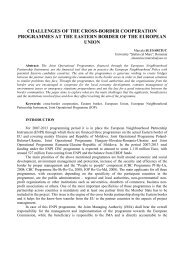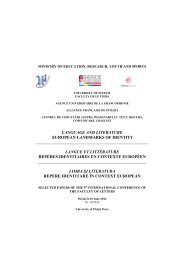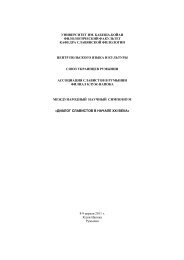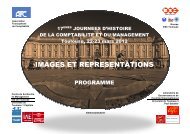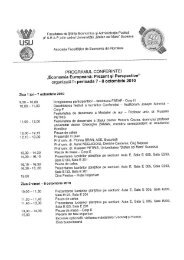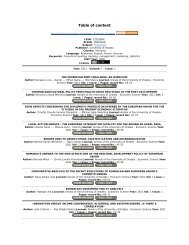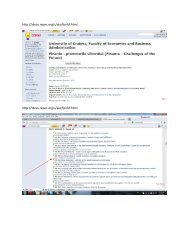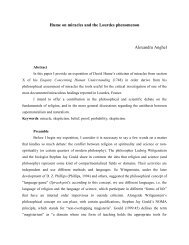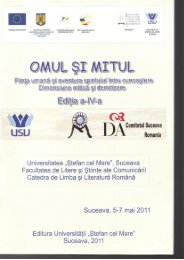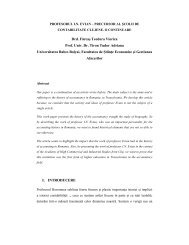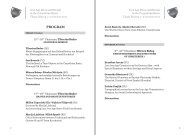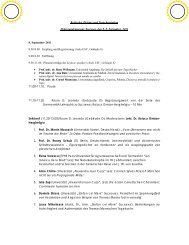1 INTRODUCTION The history of accountancy is, in a large measure ...
1 INTRODUCTION The history of accountancy is, in a large measure ...
1 INTRODUCTION The history of accountancy is, in a large measure ...
You also want an ePaper? Increase the reach of your titles
YUMPU automatically turns print PDFs into web optimized ePapers that Google loves.
<strong>INTRODUCTION</strong><br />
<strong>The</strong> <strong>h<strong>is</strong>tory</strong> <strong>of</strong> <strong>accountancy</strong> <strong>is</strong>, <strong>in</strong> a <strong>large</strong> <strong>measure</strong>, the <strong>h<strong>is</strong>tory</strong> <strong>of</strong> civilization.(Woolf<br />
(1986) .<strong>The</strong>re <strong>is</strong> a strong emphas<strong>is</strong> on attempt<strong>in</strong>g to study account<strong>in</strong>g <strong>in</strong> the contexts<br />
<strong>in</strong> which it operates (Hopwood, 1983;Napier, 1989).<br />
Our aim <strong>is</strong> to demonstrate the strong connections between the <strong>h<strong>is</strong>tory</strong> <strong>of</strong> the<br />
foundation <strong>of</strong> the ma<strong>in</strong> schools <strong>of</strong> account<strong>in</strong>g from Romania and the social<br />
economical and political context <strong>in</strong> which was created.<br />
<strong>The</strong> account<strong>in</strong>g education started <strong>in</strong> her <strong>in</strong>cipient form <strong>in</strong> XIX century <strong>in</strong> Romanian<br />
territories.<br />
<strong>The</strong> evolution <strong>of</strong> economy and merchand<strong>is</strong>e commerce required the appearance <strong>of</strong><br />
education forms, which developed <strong>in</strong> various ways on the territories <strong>in</strong>habited by<br />
Romanians.<br />
From all the Romanian territories, Transylvania was the first territory where the<br />
<strong>in</strong>stitutions <strong>of</strong> economic and account<strong>in</strong>g sciences appeared, hav<strong>in</strong>g Germanic and later<br />
on Austro-Hungarian <strong>in</strong>fluences. Tiron-Tudor A and Matiş D (2010) emphasize that<br />
the account<strong>in</strong>g system <strong>in</strong> 19 th century <strong>in</strong> Transylvania was <strong>in</strong>fluenced by German<br />
models.<br />
<strong>The</strong> first works <strong>in</strong> Romanian, <strong>in</strong> the field <strong>of</strong> account<strong>in</strong>g, appeared on the<br />
Transylvanian territory, as here was an education form <strong>in</strong>tended for the tra<strong>in</strong><strong>in</strong>g <strong>of</strong> the<br />
population <strong>in</strong> the field <strong>of</strong> commerce.<br />
<strong>The</strong> organization <strong>of</strong> the higher education <strong>in</strong> Romanian language, <strong>in</strong> Transylvania,<br />
more exactly <strong>in</strong> Cluj – Napoca, had several attempts and restra<strong>in</strong>ts, but eventually,<br />
they succeeded <strong>in</strong> sett<strong>in</strong>g here a higher education <strong>in</strong>stitution, with a major <strong>in</strong><br />
economy, which represents today the precursor <strong>of</strong> the greatest Faculty <strong>of</strong> Economic<br />
Sciences from Romania.<br />
One <strong>of</strong> the first higher education Institution <strong>in</strong> the field <strong>of</strong> economy, and particularly<br />
<strong>in</strong> the field <strong>of</strong> account<strong>in</strong>g <strong>in</strong> Romanian language, was settled <strong>in</strong> Cluj, <strong>in</strong> 1919, after the<br />
Great Unification. Th<strong>is</strong> was called the Academy <strong>of</strong> High Commercial and Industrial<br />
Studies from Cluj and it can be considered the first form <strong>of</strong> higher education <strong>in</strong> the<br />
<strong>accountancy</strong> field from Transylvania. <strong>The</strong> <strong>in</strong>stitution carried out its activity for 20<br />
years <strong>in</strong> the town <strong>of</strong> Cluj, and then it was entirely moved to Brasov due to political<br />
changes.<br />
Our attention will be focused on Cluj first form <strong>of</strong> higher education <strong>in</strong> the<br />
<strong>accountancy</strong> field. <strong>The</strong>re are some reasons for tak<strong>in</strong>g a particular <strong>in</strong>stitutional focus,<br />
as well as for select<strong>in</strong>g specifically the Cluj Account<strong>in</strong>g School as the purview <strong>of</strong><br />
<strong>in</strong>terest. Firstly, the specific choice <strong>of</strong> the Cluj Account<strong>in</strong>g School for an exploration<br />
<strong>of</strong> the <strong>in</strong>terrelations between its beg<strong>in</strong>n<strong>in</strong>g and the social, economical and political<br />
context at that period <strong>is</strong> because it <strong>is</strong> an <strong>in</strong>stitution with a rich cultural and social<br />
<strong>h<strong>is</strong>tory</strong>, which has and cont<strong>in</strong>ues to have, a marked <strong>in</strong>fluence on the account<strong>in</strong>g<br />
research and op<strong>in</strong>ions at national level. Secondly, the specific <strong>of</strong> the period <strong>in</strong> which<br />
the First Romanian account<strong>in</strong>g school was set up <strong>in</strong> Transylvania. Thirdly, as on <strong>of</strong><br />
the oldest account<strong>in</strong>g educational <strong>in</strong>stitution <strong>in</strong> Romania, with over 90 years <strong>of</strong><br />
activity deserve an <strong>in</strong>stitutional <strong>h<strong>is</strong>tory</strong>. Institutional <strong>h<strong>is</strong>tory</strong> works commonly appear<br />
<strong>in</strong> celebration <strong>of</strong> a key anniversary, as part <strong>of</strong> account<strong>in</strong>g <strong>h<strong>is</strong>tory</strong>’s role <strong>in</strong> enhanc<strong>in</strong>g<br />
the status <strong>of</strong> account<strong>in</strong>g and those who practice it. (Carnegie, Napier 1996)<br />
1
<strong>The</strong> article <strong>is</strong> divided <strong>in</strong>to three major parts. <strong>The</strong> first briefly <strong>in</strong>troduces the reader <strong>in</strong>to<br />
the subject <strong>of</strong> research by present<strong>in</strong>g the subject importance and the reasons for<br />
choos<strong>in</strong>g th<strong>is</strong> subject. <strong>The</strong> methodology used <strong>is</strong> presented <strong>in</strong> the second part, the third<br />
part provides the heart <strong>of</strong> analys<strong>is</strong> and <strong>is</strong> structured <strong>in</strong> three sections one for each<br />
period <strong>of</strong> time. For each period, the social economical and political context <strong>is</strong><br />
explored <strong>in</strong> the beg<strong>in</strong>n<strong>in</strong>g and we cont<strong>in</strong>ue with captur<strong>in</strong>g the determ<strong>in</strong>ant elements <strong>of</strong><br />
the evolution <strong>of</strong> Transylvanian account<strong>in</strong>g school.<br />
F<strong>in</strong>ally, the conclud<strong>in</strong>g section summaries the article as well as presents some wider<br />
implication <strong>of</strong> the analys<strong>is</strong>.<br />
1. RESEARCH METHODOLOGY<br />
We develop a qualitative, explanatory study <strong>in</strong>volv<strong>in</strong>g a contextual analys<strong>is</strong> with the<br />
<strong>in</strong>tention to elucidate the cont<strong>in</strong>gent nature <strong>of</strong> the Transylvanian account<strong>in</strong>g school<br />
evolution by describ<strong>in</strong>g events as they occur, with the goal <strong>of</strong> captur<strong>in</strong>g all <strong>of</strong> the<br />
richness <strong>of</strong> everyday behaviour and with the hope <strong>of</strong> d<strong>is</strong>cover<strong>in</strong>g and understand<strong>in</strong>g<br />
phenomena that might have been m<strong>is</strong>sed if only more cursory exam<strong>in</strong>ations have been<br />
made.<br />
<strong>The</strong> purpose <strong>of</strong> our h<strong>is</strong>torical writ<strong>in</strong>g <strong>is</strong>:<br />
- to tell the story <strong>in</strong> the present <strong>of</strong> someth<strong>in</strong>g happened <strong>in</strong> the past ( Munslow, 2001)<br />
- to expla<strong>in</strong> why certa<strong>in</strong> th<strong>in</strong>gs <strong>in</strong> the past happened as they did ( Rampolla, 2004)<br />
- to became aware <strong>of</strong>, appreciate and judge perspectives others than one’s own both<br />
through h<strong>is</strong>torical data and through <strong>in</strong>terpretation <strong>of</strong> what other h<strong>is</strong>torians have said(<br />
Marius & Page, 2009)<br />
Under Parker (1993) criteria, our study should be classified as be<strong>in</strong>g written “from the<br />
<strong>in</strong>side” due to the authors affiliation at th<strong>is</strong> school. We follow <strong>in</strong> our research the<br />
model <strong>of</strong> h<strong>is</strong>torical works on account<strong>in</strong>g bodies used by Brown (1905), Garrett<br />
(1961), Institute <strong>of</strong> Chartered Accountants <strong>of</strong> Scotland (1954), Institute <strong>of</strong> Chartered<br />
Accountants <strong>in</strong> England and Wales (1966) and Carey (1969) as examples <strong>of</strong> works<br />
which had been written “from the <strong>in</strong>side”.<br />
From a methodological po<strong>in</strong>t <strong>of</strong> view, it was conducted a thorough study <strong>of</strong> relevant<br />
(ma<strong>in</strong>ly Romanian) literature available (textual analys<strong>is</strong>). We have studied primary<br />
and secondary data <strong>of</strong> <strong>in</strong>formation about the Transylvania <strong>h<strong>is</strong>tory</strong>, account<strong>in</strong>g<br />
education <strong>in</strong> Romania, and about the Academy <strong>of</strong> High Commercial and Industrial<br />
Studies written <strong>in</strong> Romanian language, Engl<strong>is</strong>h and French <strong>in</strong> order to become<br />
familiarized with the process <strong>of</strong> account<strong>in</strong>g education <strong>in</strong> Transylvania changes<br />
through time.<br />
Furthermore, <strong>in</strong> order to get an understand<strong>in</strong>g <strong>of</strong> account<strong>in</strong>g literature <strong>in</strong> different<br />
periods <strong>of</strong> time, and <strong>of</strong> the development <strong>of</strong> an account<strong>in</strong>g literature (and thought) <strong>in</strong><br />
Romania, there were been studied older (beg<strong>in</strong>n<strong>in</strong>g <strong>of</strong> the 20th century) and newer<br />
Romanian account<strong>in</strong>g books.<br />
<strong>The</strong> analyzed period was split <strong>in</strong>to three d<strong>is</strong>t<strong>in</strong>ct periods with the reason <strong>of</strong> captur<strong>in</strong>g<br />
the events chronology:<br />
- the development phase - before the 1918, when modern Romania was formed<br />
2
- the mature phase <strong>of</strong> Transylvanian Account<strong>in</strong>g School <strong>in</strong> Cluj - between 1918 and<br />
1940<br />
- the decl<strong>in</strong>e phase <strong>of</strong> Transylvanian Account<strong>in</strong>g School <strong>in</strong> Brasov – between 1940-<br />
1950<br />
We analyzed <strong>in</strong>dividually each <strong>of</strong> the three periods because accord<strong>in</strong>gly with the<br />
Punctuated equilibrium theory, there were three stas<strong>is</strong> (- long period <strong>of</strong> relatively<br />
unchanged form) and three punctuation (radical change over a short duration):<br />
- 1918 the year when all Romanian territory were unified, and the modern<br />
Romania was formed<br />
- 1940 the year when the Academy <strong>of</strong> High Commercial and Industrial Studies<br />
was refugee <strong>in</strong> Brasov, due to the Vienna Diktat 30 august 1940,<br />
- 1950 the year when the Institute <strong>of</strong> Economic sciences and forecast<strong>in</strong>g (the<br />
transformed name <strong>of</strong> the Academy) was d<strong>is</strong>solved.<br />
However, after 10 years, the Transylvanian account<strong>in</strong>g school was reborn like<br />
Phoenix bird. In 1961 was founded <strong>in</strong> Cluj, <strong>The</strong> Faculty <strong>of</strong> Economic Sciences <strong>in</strong> the<br />
framework <strong>of</strong> Babes Bolyai University who cont<strong>in</strong>ued the tradition <strong>of</strong> Academy <strong>of</strong><br />
High Commercial and Industrial Studies.<br />
<strong>The</strong> punctuated equilibrium theory was used for the first time <strong>in</strong> account<strong>in</strong>g research<br />
by Alexander and Servalli (2010), to <strong>in</strong>vestigate the complex process <strong>of</strong> account<strong>in</strong>g<br />
change. <strong>The</strong> model <strong>of</strong> Alexander and Servalli was used by Albu, Albu and Alexander<br />
(2010) to analyses the processes and causes <strong>of</strong> change <strong>in</strong> <strong>h<strong>is</strong>tory</strong> <strong>of</strong> Romanian<br />
account<strong>in</strong>g. <strong>The</strong> ma<strong>in</strong> objective <strong>of</strong> the study was to explore the Romanian account<strong>in</strong>g<br />
h<strong>is</strong>tories <strong>in</strong> the context <strong>of</strong> the model as proposed by Alexander and Servalli (2010), <strong>in</strong><br />
order to critically exam<strong>in</strong>e Romanian attitudes and perceptions today and suggest a<br />
number <strong>of</strong> rational predictions <strong>of</strong> likely future developments <strong>in</strong> an EU/IFRS<br />
environment, <strong>in</strong> a world where account<strong>in</strong>g seeks to serve organizations <strong>of</strong> vastly<br />
different sizes, with vastly different user needs, <strong>in</strong> vastly different attitud<strong>in</strong>al contexts.<br />
Tosh (1991:12-13) expla<strong>in</strong>ed the fundamental prem<strong>is</strong>es <strong>of</strong> h<strong>is</strong>toric<strong>is</strong>m as follows:<br />
,,Each age <strong>is</strong> a unique manifestation <strong>of</strong> the human spirit, with its own culture and<br />
values. For one age to understand another there must be recognition that the passage<br />
<strong>of</strong> time has pr<strong>of</strong>oundly altered both the conditions <strong>of</strong> life and the mentality <strong>of</strong> men and<br />
women – even perhaps human nature itself – and that an effort <strong>of</strong> the imag<strong>in</strong>ation<br />
must be made to rel<strong>in</strong>qu<strong>is</strong>h present-day values and to see an earlier age from the<br />
<strong>in</strong>side.”<br />
For th<strong>is</strong> reason, <strong>in</strong> our research we consider important to analyze the coord<strong>in</strong>ates <strong>of</strong><br />
the Transylvanian account<strong>in</strong>g school evolution l<strong>in</strong>ked with the economic<br />
environment, the h<strong>is</strong>torical context at the national level. In th<strong>is</strong> respect we’ll try to<br />
look at the ma<strong>in</strong> def<strong>in</strong><strong>in</strong>g moments <strong>of</strong> the account<strong>in</strong>g <strong>h<strong>is</strong>tory</strong> marked by the evolution<br />
<strong>of</strong> capital<strong>is</strong>m and implicitly the development <strong>of</strong> Transylvanian account<strong>in</strong>g school.<br />
We apply the contextual analys<strong>is</strong>, that helps us to assess the text with<strong>in</strong> the context <strong>of</strong><br />
its h<strong>is</strong>torical and cultural sett<strong>in</strong>g. A contextual analys<strong>is</strong> comb<strong>in</strong>es features <strong>of</strong> formal<br />
analys<strong>is</strong> with features <strong>of</strong> “cultural archaeology,” or the systematic study <strong>of</strong> social,<br />
political, economic, philosophical, religious, and aesthetic conditions that were (or<br />
can be assumed to have been) <strong>in</strong> place at the time and place when the text was<br />
created. While th<strong>is</strong> may sound complicated, it <strong>is</strong> <strong>in</strong> reality deceptively simple: it<br />
means “situat<strong>in</strong>g” the text with<strong>in</strong> the milieu <strong>of</strong> its times and assess<strong>in</strong>g the roles <strong>of</strong><br />
3
author, readers (<strong>in</strong>tended and actual), and “commentators” (critics, both pr<strong>of</strong>essional<br />
and otherw<strong>is</strong>e) <strong>in</strong> the reception <strong>of</strong> the text.<br />
Our contribution <strong>in</strong> th<strong>is</strong> paper <strong>is</strong> to identify the ma<strong>in</strong> <strong>in</strong>fluences that have an effect on<br />
the beg<strong>in</strong>n<strong>in</strong>gs <strong>of</strong> school <strong>of</strong> account<strong>in</strong>g from Cluj Transylvania <strong>in</strong> XIX century and<br />
first part <strong>of</strong> the XX century connected with the political and socio economical<br />
chang<strong>in</strong>g contexts <strong>of</strong> that h<strong>is</strong>torical period. We focus our attention ma<strong>in</strong>ly on the<br />
account<strong>in</strong>g school created <strong>in</strong> the <strong>in</strong>stitutional environment <strong>of</strong> the Academy <strong>of</strong> High<br />
Commercial and Industrial Studies. Th<strong>is</strong> <strong>is</strong> due to the excellence <strong>of</strong> th<strong>is</strong> school <strong>of</strong><br />
account<strong>in</strong>g, tak<strong>in</strong>g <strong>in</strong>to considerations the follows arguments: the ancientness <strong>of</strong> the<br />
school, the school reputation, pr<strong>of</strong>essors' fame, the ideas presented <strong>in</strong> school research<br />
journals, the activity <strong>of</strong> pr<strong>of</strong>essors association, the pr<strong>of</strong>essors' role <strong>in</strong> national<br />
account<strong>in</strong>g pr<strong>of</strong>ession organ<strong>is</strong>ation.<br />
2. TRANSYLVANIAN ACCOUNTING SCHOOL-THE DEVELOPMENT<br />
PHASE – BEFORE 1918<br />
2.1. <strong>The</strong> Romanian territories social, h<strong>is</strong>torical and economic context before 1918<br />
Before 1918 the Romanian territories were considered <strong>in</strong>dividual countries. In <strong>h<strong>is</strong>tory</strong>,<br />
Romanian pr<strong>in</strong>cipalities ex<strong>is</strong>ted ma<strong>in</strong>ly <strong>in</strong>dependently <strong>of</strong> one another (at least <strong>in</strong> a<br />
formal manner), due to ma<strong>in</strong>ly external pressures.<br />
Transylvania <strong>is</strong> one <strong>of</strong> the Romanian h<strong>is</strong>torical territories situated <strong>in</strong> the North West<br />
part <strong>of</strong> Romania. In ancient times it was part <strong>of</strong> the Dacia K<strong>in</strong>gdom and Roman Dacia.<br />
S<strong>in</strong>ce the 10th century, Transylvania became a prov<strong>in</strong>ce <strong>of</strong> the K<strong>in</strong>gdom <strong>of</strong> Hungary.<br />
After the Battle <strong>of</strong> Mohacs <strong>in</strong> 1526, it was part <strong>of</strong> the Eastern Hungarian K<strong>in</strong>gdom,<br />
out <strong>of</strong> which the Pr<strong>in</strong>cipality <strong>of</strong> Transylvania emerged. Most <strong>of</strong> the time, <strong>in</strong> the 16th<br />
and 17th century, th<strong>is</strong> Pr<strong>in</strong>cipality was vassal to the Ottoman Empire, and <strong>in</strong> some<br />
periods to the Habsburg Empire. At the end <strong>of</strong> the 17th century, Transylvania came<br />
under the control <strong>of</strong> the Habsburg Empire.<br />
From 1437 to 1848, medieval political power <strong>in</strong> Transylvania was shared between the<br />
mostly Hungarian nobility, German burghers, and the seats <strong>of</strong> the Székely people (a<br />
Hungarian ethnic group), while the population was made up by Hungarians, Szeklers<br />
and Germans and Romanians) Start<strong>in</strong>g then, Transylvania was <strong>in</strong> name attached to<br />
Habsburg-controlled Hungary, though it had a separate status, be<strong>in</strong>g subjected to the<br />
direct rule <strong>of</strong> the emperor’s governors. In practice Transylvania was severed from<br />
Hungary until 1867 when, after the Austro-Hungarian Comprom<strong>is</strong>e, the separate<br />
status <strong>of</strong> Transylvania ceased and it was <strong>in</strong>corporated <strong>in</strong>to the K<strong>in</strong>gdom <strong>of</strong> Hungary as<br />
part <strong>of</strong> Austrian-Hungarian Empire.<br />
Transylvania became part <strong>of</strong> Romania only after the First World War, and at that time<br />
the country was represented by Moldavia and Wallachia, other two Romanian<br />
territories, unified <strong>in</strong> 1859, and ga<strong>in</strong>ed their <strong>in</strong>dependence <strong>in</strong> 1878 (recognized at the<br />
<strong>in</strong>ternational level).<br />
Because all <strong>of</strong> these h<strong>is</strong>torical conditions, <strong>in</strong> Romania capital<strong>is</strong>m imposed rather late<br />
<strong>in</strong> compar<strong>is</strong>on with West European countries, which generated a slower development<br />
<strong>of</strong> account<strong>in</strong>g <strong>in</strong> our country. If <strong>in</strong> the western countries the <strong>in</strong>dustrial revolution<br />
started at the beg<strong>in</strong>n<strong>in</strong>g <strong>of</strong> the 17th century, Romania had been until the beg<strong>in</strong>n<strong>in</strong>g <strong>of</strong><br />
the 19th century a country still <strong>in</strong> late Middle Ages.<br />
4
Romania’s economy was still based on a feudal agriculture, the <strong>in</strong>dustry almost didn’t<br />
ex<strong>is</strong>t, the manufacturers, <strong>in</strong> classical view, appear<strong>in</strong>g only <strong>in</strong> the middle <strong>of</strong> 18th<br />
century. <strong>The</strong> trade, which was the ma<strong>in</strong> economic factor contribut<strong>in</strong>g to the<br />
development <strong>of</strong> capital<strong>is</strong>m had a lot to suffer <strong>in</strong> the Romanian h<strong>is</strong>torical prov<strong>in</strong>ces,<br />
be<strong>in</strong>g strongly <strong>in</strong>fluenced <strong>in</strong> the second half <strong>of</strong> the 16th century by the <strong>in</strong>stauration <strong>of</strong><br />
Turk<strong>is</strong>h and Austro Habsburg Empires monopoly (Muresan, 2007). Consequently,<br />
due to the change <strong>in</strong> <strong>in</strong>ternational context (<strong>in</strong> our <strong>in</strong>fluence sphere the Turk<strong>is</strong>h Empire<br />
starts los<strong>in</strong>g ground <strong>in</strong> favour <strong>of</strong> the Russian empire), until the beg<strong>in</strong>n<strong>in</strong>g <strong>of</strong> the 19th<br />
century when the economic life starts develop<strong>in</strong>g, account<strong>in</strong>g hadn’t been a necessity<br />
<strong>in</strong> the Romanian economic life (Dobroteanu, 2004). <strong>The</strong> ma<strong>in</strong> factors which<br />
<strong>in</strong>fluenced directly the economy <strong>of</strong> Romanian prov<strong>in</strong>ces <strong>in</strong> the 19th century are: the<br />
degree <strong>of</strong> <strong>in</strong>dustrial development, the trade development, the degree <strong>of</strong> economic<br />
autonomy, capital availability, national <strong>in</strong>dependence, etc. (Ionascu, 1997).<br />
2.2. <strong>The</strong> early beg<strong>in</strong>n<strong>in</strong>g <strong>of</strong> Transylvanian trade and account<strong>in</strong>g school<br />
Prior to the late 1800s, the terms bookkeep<strong>in</strong>g and account<strong>in</strong>g were <strong>of</strong>ten used<br />
<strong>in</strong>terchangeably because the record<strong>in</strong>g/post<strong>in</strong>g process was central to both activities.<br />
<strong>The</strong>re was little need for f<strong>in</strong>ancial statements (e.g., <strong>in</strong>come statements) because most<br />
owners had direct knowledge <strong>of</strong> their bus<strong>in</strong>esses and, therefore, could rely on<br />
elementary bookkeep<strong>in</strong>g procedures for <strong>in</strong>formation.<br />
For example, <strong>in</strong> 14th century dur<strong>in</strong>g the time <strong>of</strong> craft<strong>in</strong>g organizations, we can f<strong>in</strong>d<br />
pro<strong>of</strong> that <strong>in</strong>comes and expenses accounts were kept, reg<strong>is</strong>ters and exchanges<br />
document were used, different „stories” <strong>of</strong> economic activities ( Hr<strong>is</strong>oave) were found<br />
<strong>in</strong> towns like Sibiu, Brasov, Rasnov, giv<strong>in</strong>g evidence that account<strong>in</strong>g <strong>in</strong> its primary<br />
form was quite developed. (CECCAR)<br />
Double-entry account<strong>in</strong>g manifested certa<strong>in</strong>ly <strong>in</strong> the 17th century, <strong>in</strong> factories <strong>in</strong><br />
Sibiu, Brasov and Bucharest (Demetrescu et al., 1979, cited <strong>in</strong> Ionascu, 1997: 176).<br />
Althought there were pro<strong>of</strong>s that forms <strong>of</strong> account<strong>in</strong>g were used <strong>in</strong> the Romanian<br />
territories long before, consider<strong>in</strong>g the reg<strong>is</strong>ters and account<strong>in</strong>g books found for<br />
several very old estates <strong>of</strong> the time, but a significant development was only v<strong>is</strong>ible<br />
start<strong>in</strong>g the second half <strong>of</strong> the 18th century, when commerce began develop<strong>in</strong>g.<br />
<strong>The</strong>re were some towns from Transylvania: Sibiu, Brasov and Rasnov, that were<br />
situated <strong>in</strong> the eastern border <strong>of</strong> Habsburgic Empire, and had the majority <strong>of</strong> the<br />
citizens Saxons. <strong>The</strong>se people were brought <strong>in</strong> by the Hungarian k<strong>in</strong>g to repel the<br />
Turks and they came <strong>in</strong> the area with their habits, traditions, knowledge and<br />
mentalities. <strong>The</strong> cities flour<strong>is</strong>hed with trade, be<strong>in</strong>g coveted by its neighbors. <strong>The</strong>se<br />
towns were important trad<strong>in</strong>g centers, act<strong>in</strong>g as <strong>in</strong>termediaries <strong>in</strong> the long-d<strong>is</strong>tance<br />
trade between Western and Central Europe and the Ottoman Empire.<br />
For th<strong>is</strong> reason at the beg<strong>in</strong>n<strong>in</strong>g <strong>of</strong> XIX century Transylvania, the eastern part <strong>of</strong><br />
Habsburgic Empire had an economy more developed if we compare with other parts<br />
<strong>of</strong> Romanian territories ( Moldavia and Wallachia).<br />
<strong>The</strong> Transylvania economy was characterized by a developed structure <strong>of</strong> trade and<br />
<strong>in</strong>dustry, and have bequeathed to us account<strong>in</strong>g records.<br />
<strong>The</strong> fact that account<strong>in</strong>g has <strong>in</strong>variably been associated with societies where bus<strong>in</strong>ess<br />
has flour<strong>is</strong>hed was to Hatfield "so obvious that I <strong>of</strong>fend by explanation. Wherever<br />
trade flour<strong>is</strong>hed, the practice <strong>of</strong> double-entry could be found, lend<strong>in</strong>g color to the<br />
5
views that trade followed double entry, or that double-entry followed trade.”<br />
(Hatfield, 1950)<br />
As Bedford (1970) expla<strong>in</strong>s “h<strong>is</strong>torically the process by which account<strong>in</strong>g procedures<br />
and thought has been transmitted from one country to another has been by the<br />
physical transfer <strong>of</strong> accountants.”<br />
<strong>The</strong> <strong>in</strong>vention <strong>of</strong> account<strong>in</strong>g was vital to the development <strong>of</strong> the capital<strong>is</strong>tic enterpr<strong>is</strong>e.<br />
In particular, double-entry bookkeep<strong>in</strong>g permitted the full representation <strong>of</strong> the flow<br />
<strong>of</strong> capital through a bus<strong>in</strong>ess.<br />
However, <strong>in</strong> the late 1820s the numbers <strong>of</strong> corporations rapidly <strong>in</strong>creased and to<br />
operate successfully, were needed cost reports, production reports, f<strong>in</strong>ancial<br />
statements, and operat<strong>in</strong>g ratios that were more complex than simple record<strong>in</strong>g<br />
procedures could provide.<br />
Referr<strong>in</strong>g aga<strong>in</strong> to Transylvania and trade, we can give as an example the spices, that<br />
were a major element <strong>in</strong> the transit trade<strong>of</strong>f oriental goods. Pakucs studied the subject<br />
us<strong>in</strong>g data available from the beg<strong>in</strong>n<strong>in</strong>g and from the fifth decade <strong>of</strong> the sixteenth<br />
century: the customs reg<strong>is</strong>ters as primary sources for reconstruct<strong>in</strong>g commercial<br />
traffic. Us<strong>in</strong>g a comparative approach the author presents the amounts <strong>of</strong> different<br />
spices that reached Transylvania through the customs <strong>of</strong> Brasov and Sibiu. Although<br />
Brasov attracted a far <strong>large</strong>r amount <strong>of</strong> goods and number <strong>of</strong> traders than Sibiu, the<br />
latter surpassed Brasov <strong>in</strong> the trade with saffron and other spices. Apart from pepper,<br />
the quantities <strong>of</strong> spices brought to the Saxon towns via Wallachia are not very<br />
impressive.(Pakucs 2002)<br />
For centuries, the city <strong>of</strong> Brasov was (and still <strong>is</strong>) Transylvania's gateway towards the<br />
South and East. As the renowned Harvard pr<strong>of</strong>essor Samuel Hunt<strong>in</strong>gton shows <strong>in</strong> h<strong>is</strong><br />
work "<strong>The</strong> Clash <strong>of</strong> Civilizations", th<strong>is</strong> <strong>is</strong> where (ideologically) Europe ends. <strong>The</strong><br />
fault l<strong>in</strong>e between the western and the eastern civilization runs <strong>in</strong>deed through Brasov,<br />
separat<strong>in</strong>g Transylvania from the rest <strong>of</strong> Romania.(Hunt<strong>in</strong>gton, 2003)<br />
Due to its geographical position, at the crossroads <strong>of</strong> Moldavia and Wallachia, Brasov<br />
has had a fast economic growth, becom<strong>in</strong>g one <strong>of</strong> the most important markets <strong>in</strong><br />
Transylvania. On the 14th century Brasov became one <strong>of</strong> the most economical and<br />
political strongholds <strong>in</strong> the Southeast <strong>of</strong> Europe and on the 16th century also a cultural<br />
center. Johannes Honterus, a great German human<strong>is</strong>t, worked most <strong>of</strong> the time <strong>in</strong><br />
Brasov and Deaconu Coresi pr<strong>in</strong>ted the first Romanian book also <strong>in</strong> Brasov.<br />
2.2.1. Books<br />
<strong>The</strong> first trade book, who precede the Romanian account<strong>in</strong>g literature <strong>is</strong> considered to<br />
be the paper "Izvod pentru lucrurile de obste si dechil<strong>in</strong> în scr<strong>is</strong>ori de multe chipuri"<br />
(Sibiu, Petre Bart pr<strong>in</strong>t<strong>in</strong>g house), a translation from Slavonic language made <strong>in</strong> 1792<br />
by Dimitrie Evstatievici, who was a school director. <strong>The</strong> book contents models for<br />
contracts, receipts, accounts, trade bills etc.<br />
In 1837 , <strong>in</strong> Brasov , <strong>is</strong> publ<strong>is</strong>hed the first double entry bookkeep<strong>in</strong>g <strong>in</strong> Romanian<br />
language, “Pravila comerciala” under the signature <strong>of</strong> the well known teacher from<br />
Brasov Emanoil Ioan Nechifor that <strong>of</strong>fers <strong>in</strong> th<strong>is</strong> way a good example for other<br />
account<strong>in</strong>g teachers and practitioners. It <strong>is</strong> worth say<strong>in</strong>g that Nechifor creates h<strong>is</strong> own<br />
terms, <strong>in</strong> Romanian, which was very important and hard to do at that moment. <strong>The</strong><br />
first account<strong>in</strong>g manual written <strong>in</strong> Romanian <strong>in</strong>cludes procedures and economic<br />
6
calculus, pr<strong>in</strong>ciples <strong>of</strong> commercial moral and ethics, notions <strong>of</strong> adm<strong>in</strong><strong>is</strong>tration and<br />
commercial law. <strong>The</strong> Nechifor account<strong>in</strong>g book was a translation from the German<br />
language Practical usage <strong>of</strong> double entry account<strong>in</strong>g. Some other translations <strong>of</strong> that<br />
period, publ<strong>is</strong>hed <strong>in</strong> the 1830s and 1840s were adapted from French - J. J. Jaclot, La<br />
tenue des livres enseignée en v<strong>in</strong>gt et une leçons - and German (CECCAR, 2006;<br />
Drăgănescu-Brateş, 1941). Some time later, <strong>in</strong> 1844, <strong>in</strong> Bucharest was publ<strong>is</strong>hed by<br />
Dimitrie Jarcu the paper „Scriptura Doppia or the bookkeep<strong>in</strong>g”.<br />
Allow<strong>in</strong>g for the difference <strong>in</strong> context, Rusu et al. (1991: 52) compare the<br />
contribution <strong>of</strong> Nichifor for Romania with that <strong>of</strong> Luca Pacioli at the <strong>in</strong>ternational<br />
level, as they consider fundamental Nichifor’s work <strong>of</strong> d<strong>is</strong>sem<strong>in</strong>at<strong>in</strong>g <strong>in</strong> Romanian a<br />
first treat<strong>is</strong>e <strong>of</strong> account<strong>in</strong>g and commerce, us<strong>in</strong>g mathematics and economic<br />
philosophy, religious and laic literature <strong>in</strong> order to <strong>in</strong>fluence merchants and<br />
accountants.<br />
Due to the economic growth, <strong>accountancy</strong> also has a significant r<strong>is</strong>e: there appeared a<br />
series <strong>of</strong> works about <strong>accountancy</strong>, such as those belong<strong>in</strong>g to Honoriu Warta<br />
(“T<strong>in</strong>erea reg<strong>is</strong>trelor în partida simpla si în partida dubla” – S<strong>in</strong>gle and double entry<br />
bookkeep<strong>in</strong>g <strong>in</strong> 1873), Ion Ionescu de la Brad (“Mic tratat de contabilitate”<br />
Account<strong>in</strong>g small book <strong>in</strong> 1870), Dimitrie Iarcu (“Contabilitatea casnica” House<br />
Account<strong>in</strong>g <strong>in</strong> 1863 and “Contabilitatea agricola” Agricultural account<strong>in</strong>g <strong>in</strong> 1870),<br />
<strong>The</strong>odor Stefanescu (“Contabilitate în partida dubla” Double entry account<strong>in</strong>g <strong>in</strong><br />
1873) and other.<br />
Only <strong>in</strong> the second part <strong>of</strong> XIX century we can speak about the beg<strong>in</strong>n<strong>in</strong>g <strong>of</strong><br />
Romanian account<strong>in</strong>g th<strong>in</strong>k<strong>in</strong>g. <strong>The</strong> writ<strong>in</strong>gs <strong>of</strong> the time prove that until 1888 there<br />
hadn’t been an <strong>of</strong>ficial organization <strong>of</strong> a guild <strong>of</strong> accountants <strong>in</strong> Romania. Until that<br />
moment there had been only the d<strong>is</strong>t<strong>in</strong>ction between an accountant and a bookkeeper.<br />
In th<strong>is</strong> sense, Stefanescu (1874: 93) believes that an accountant needs economics,<br />
f<strong>in</strong>ance, math knowledge, the difference between the two pr<strong>of</strong>essional categories<br />
be<strong>in</strong>g like the one between an architect and a mason. ( Zel<strong>in</strong>schi)<br />
In 1874 Pr<strong>of</strong>essor <strong>The</strong>odor Stefanescu publ<strong>is</strong>hed „<strong>The</strong> course <strong>of</strong> double entry<br />
account<strong>in</strong>g”. Even if h<strong>is</strong> source <strong>of</strong> <strong>in</strong>spiration were ma<strong>in</strong>ly French authors, we must<br />
say that h<strong>is</strong> study can be considered the first study that was no longer a simple<br />
translation <strong>of</strong> compilation. It opened a new way for the Romanian account<strong>in</strong>g th<strong>in</strong>k<strong>in</strong>g<br />
and practice.<br />
Up to the end <strong>of</strong> XIX century we can observe that a great number <strong>of</strong> translations and<br />
orig<strong>in</strong>al works regard<strong>in</strong>g account<strong>in</strong>g are publ<strong>is</strong>hed <strong>in</strong> the important centers <strong>of</strong> culture<br />
and economy such as Brasov and Cluj <strong>in</strong> Transylvania, Bucharest, Iasi and Galati <strong>in</strong><br />
other Romanian territories.<br />
2.2.2. Influence <strong>of</strong> European practices<br />
Transylvanians movements derived their <strong>in</strong>spiration from the eighteenth-century<br />
European Enlightenment. Younger were students <strong>of</strong> the French Enlightenment and<br />
<strong>of</strong> German classic<strong>is</strong>m. Samuil Micu, the founder <strong>of</strong> modern Romania, was deeply<br />
<strong>in</strong>fluenced by the contemporary Austrian Enlightenment as a student at the<br />
University <strong>of</strong> Vienna. Other examples abound. It <strong>is</strong> conclusive that the common<br />
heritage <strong>of</strong> movements <strong>in</strong>cluded a keen assimilation <strong>of</strong> the Enlightenment and a<br />
strong desire to improve Transylvanian society.<br />
7
XIX century <strong>in</strong> Romanian account<strong>in</strong>g <strong>is</strong> a period that may be characterized by the<br />
adoption <strong>of</strong> the best European account<strong>in</strong>g practices. (Tiron , Mutiu) In the context <strong>of</strong><br />
the advanteges <strong>of</strong> the Romanian territories position (“a bridge between Central Europe<br />
and the Far East”), Rusu et al. (1991: 50-51) show the possitive <strong>in</strong>fuence <strong>of</strong> tranzit<br />
commerce on account<strong>in</strong>g development.<br />
In XIX century, the numerous theories <strong>of</strong> „accounts” aimed at f<strong>in</strong>d<strong>in</strong>g the basic rules<br />
<strong>of</strong> keep<strong>in</strong>g books, sough to d<strong>is</strong>entangle the „mystery” <strong>of</strong> double-entry. Among the<br />
most frequently mentioned authors deal<strong>in</strong>g with two and four series theories were<br />
several Italian scholars: Cerboni Giuseppe (1827-1917 and Tuscan school with h<strong>is</strong><br />
„log<strong>is</strong>mografi”, Francesco Villa and the lombardian school and Fabio Besta and the<br />
Venetian school with their material<strong>is</strong>tic theory <strong>of</strong> accounts. <strong>The</strong>se theories was<br />
developed <strong>in</strong> time by Edmond Degranges- the father.<br />
Given the presence <strong>of</strong> Venetian or Genovese merchants (start<strong>in</strong>g 1200) on Romanian<br />
territories, there can be no doubt that Romanians learned account<strong>in</strong>g and bookkeep<strong>in</strong>g<br />
pr<strong>in</strong>ciples from them.<br />
At the beg<strong>in</strong>n<strong>in</strong>g <strong>of</strong> the n<strong>in</strong>eteenth century the former glory <strong>of</strong> Italian account<strong>in</strong>g was<br />
overshadowed by its decl<strong>in</strong>e dur<strong>in</strong>g the eighteenth century, and account<strong>in</strong>g literature<br />
from France, England, and Germany took centre-stage.<br />
Concern<strong>in</strong>g the <strong>in</strong>fluence <strong>of</strong> foreign literature, Demetrescu underl<strong>in</strong>e that the French<br />
literature was used <strong>in</strong> the south part <strong>of</strong> Romanian territories ( Muntenia), while the<br />
Italian literature was used <strong>in</strong> Moldavia and the German literature <strong>in</strong> Transylvania.<br />
<strong>The</strong>re were also some theories <strong>in</strong> the <strong>accountancy</strong> field at that time. “<strong>The</strong>ories <strong>of</strong><br />
accounts” (rather than “account<strong>in</strong>g theories”) dom<strong>in</strong>ated not merely the early but also<br />
the later part <strong>of</strong> th<strong>is</strong> century when Italian account<strong>in</strong>g had rega<strong>in</strong>ed a prom<strong>in</strong>ent<br />
position beside other countries. <strong>The</strong> relation <strong>of</strong> those theories to the “charts <strong>of</strong><br />
accounts”-which later became so prom<strong>in</strong>ent <strong>in</strong> Cont<strong>in</strong>ental Europe <strong>is</strong> h<strong>is</strong>torically<br />
important.<br />
Different authors <strong>of</strong> XIX century support theories based on <strong>in</strong>dividual study or<br />
material<strong>is</strong>tic theories. <strong>The</strong> former (theories based on <strong>in</strong>dividual study) tried to<br />
identify every account with a person responsible for it, while the material<strong>is</strong>tic<br />
theories derided such an attempt. Another d<strong>is</strong>pute was how many classes <strong>of</strong> accounts<br />
were used. <strong>The</strong>ir numbers orig<strong>in</strong>ally ranged from one to about five. Many<br />
comb<strong>in</strong>ations <strong>of</strong> these criteria ex<strong>is</strong>ted. In XIX century another scientific d<strong>is</strong>pute was<br />
between entity versus proprietary theories, as well as the emergence <strong>of</strong> other<br />
theories. ( Mattessich, 2003)<br />
Schar developed material<strong>is</strong>tic theories with two classes <strong>of</strong> accounts, the most<br />
successful category. He was the father <strong>of</strong> one version <strong>of</strong> the basic equations (A-L) =<br />
OE which was to <strong>in</strong>dicate that the accounts <strong>of</strong> assets and liabilities form one s<strong>in</strong>gle<br />
category, and those <strong>of</strong> owners equity form the other. Th<strong>is</strong> theory was advanced by<br />
Hugli and above all Schar.<br />
In XIX century <strong>in</strong> Transylvania was used the most successful theory <strong>of</strong> that times, a<br />
developed theory <strong>of</strong> Venetian school. Hugli’s material<strong>is</strong>tic theory <strong>of</strong> two accounts<br />
classes. Th<strong>is</strong> was further developed by another Sw<strong>is</strong>s Schar whose „closed accounts<br />
system” was regarded by Scherpf (1955:8) as the f<strong>is</strong>t chart <strong>of</strong> accounts <strong>in</strong> the proper<br />
sense.<br />
8
2.2.3. Account<strong>in</strong>g personalities<br />
Account<strong>in</strong>g <strong>is</strong> a human construction. Contemporary account<strong>in</strong>g cannot be<br />
understood without reference to the key personalities who have contributed to<br />
account<strong>in</strong>g development (Millerson, 1964, p. 50; Parker, 1993). Recent studies on<br />
the formation <strong>of</strong> the account<strong>in</strong>g pr<strong>of</strong>ession may present pitfalls to h<strong>is</strong>torians who<br />
choose to undertake explanatory biographical <strong>in</strong>vestigations <strong>of</strong> account<strong>in</strong>g’s past. In<br />
an article Napier (1989) refers to these studies and their authors. <strong>The</strong>se studies<br />
propose different factors such as social class (Macdonald, 1984), gender (Kirkham<br />
and L<strong>of</strong>t, 1993; Roberts and Coutts, 1992), political acuity (Willmott, 1986),<br />
relations with the State (Chua and Poullaos, 1993; Chua and S<strong>in</strong>clair, 1994;<br />
Poullaos, 1993) and l<strong>in</strong>ks with other pr<strong>of</strong>essions (Kedslie, 1990a; Macdonald, 1984)<br />
as determ<strong>in</strong>ants <strong>of</strong> the pr<strong>of</strong>essionalization <strong>of</strong> account<strong>in</strong>g.<br />
Emanoil Ion Nikifor the first author <strong>of</strong> an account<strong>in</strong>g book <strong>in</strong> Romanian language<br />
was teacher at Trade School <strong>in</strong> Brasov. H<strong>is</strong> book pr<strong>in</strong>t<strong>in</strong>g cost was sponsored by<br />
Gheorghe Nica, a great trader who was <strong>in</strong> the sale tile the superv<strong>is</strong>or <strong>of</strong> Trade<br />
School, founded by Gheorghe Baritiu, <strong>in</strong> 1837 <strong>in</strong> Brasov. In <strong>in</strong>troduction, Nichifor<br />
present h<strong>is</strong> good <strong>in</strong>tention to help h<strong>is</strong> colleagues with a book wrote <strong>in</strong> Romanian<br />
language follow<strong>in</strong>g the Austrian model <strong>of</strong> account<strong>in</strong>g. Also <strong>in</strong> the book were used as<br />
well a lot <strong>of</strong> Germans words: Weksselgeschaft, Gericht, Komm<strong>is</strong>sion-Buch., etc.<br />
Another important personality for the Romania and Transylvania was I. C. Pantu. He<br />
was born <strong>in</strong> Brasov <strong>in</strong> 1860, and after the high school, <strong>in</strong> 1879 he went to Vienna to<br />
cont<strong>in</strong>ue h<strong>is</strong> studies at Trade Academy. In parallel he was student at Philosophy and<br />
Polytechnic University. At h<strong>is</strong> return <strong>in</strong> Brasov <strong>in</strong> 1882 he start to teach account<strong>in</strong>g<br />
and bus<strong>in</strong>ess correspondence at Commercial school Andrei Birseanu till h<strong>is</strong><br />
retirement <strong>in</strong> 1921. In 1898 Pantu publ<strong>is</strong>hed h<strong>is</strong> firs double entry account<strong>in</strong>g book<br />
and some others after 1900. In h<strong>is</strong> books <strong>in</strong>troduction Pantu mentioned that he was<br />
<strong>in</strong>spired by German literature <strong>of</strong> Kurtzbauer, Augspurg, Ziegler,Schar, Hugli, Re<strong>is</strong>ch<br />
, Kreibig and French literature <strong>of</strong> Leautey, Guilbaut, Granges, Andoyer and Mertens.<br />
He declared himself to be pro for the material<strong>is</strong>tic theory with three series <strong>of</strong><br />
accounts and a supporter <strong>of</strong> mathematical concept <strong>of</strong> account<strong>in</strong>g.<br />
2.2.4. Account<strong>in</strong>g vocational schools<br />
C. G. Demetrescu considers that <strong>in</strong>clud<strong>in</strong>g account<strong>in</strong>g as a study object <strong>in</strong> the<br />
teach<strong>in</strong>g system had an important impact <strong>in</strong> the development <strong>of</strong> the account<strong>in</strong>g used<br />
<strong>in</strong> the Romanian states. In th<strong>is</strong> respect, after 1831, the teach<strong>in</strong>g curricula for the<br />
secondary schools, <strong>in</strong>cluded subjects with a pr<strong>of</strong>ound commercial character,<br />
account<strong>in</strong>g <strong>in</strong>cluded.<br />
In Transylvania, the roots <strong>of</strong> account<strong>in</strong>g schools start up <strong>in</strong> Cluj and Brasov. In<br />
1837 the Trade School from Brasov curricula contents account<strong>in</strong>g d<strong>is</strong>cipl<strong>in</strong>e , and<br />
the course book was Pravila Comerciala writed by Emanoil Ioan Nichifor.<br />
Also, <strong>in</strong> other Romanian territory, like Iasi <strong>in</strong> 1838, Braila <strong>in</strong> 1843 and Bucharest <strong>in</strong><br />
1844, account<strong>in</strong>g d<strong>is</strong>cipl<strong>in</strong>e was <strong>in</strong>cluded <strong>in</strong> trade schools curricula.<br />
In XIX century the economic development requests qualified employees <strong>in</strong><br />
<strong>in</strong>dustrial, agricultural and trade activities. For th<strong>is</strong> reason, Trade and Industry<br />
Chambers from Transylvania (founded by law <strong>in</strong> 1850) supported the foundation <strong>of</strong><br />
commercial schools for trade and other bus<strong>in</strong>ess activities. In Transylvania were 14<br />
9
commercial schools with a three years study curricula <strong>in</strong>clud<strong>in</strong>g d<strong>is</strong>cipl<strong>in</strong>e like: trade<br />
<strong>h<strong>is</strong>tory</strong>, account<strong>in</strong>g, bus<strong>in</strong>ess correspondence, commercial mathematics, economics<br />
pr<strong>in</strong>ciples, and commercial law. In parallel, there were some projects concern<strong>in</strong>g the<br />
foundation <strong>of</strong> higher studies <strong>in</strong> economics.<br />
In 1835, <strong>in</strong> Cluj was founded the Normal Trade School and <strong>in</strong> the second part <strong>of</strong> XIX<br />
century was founded the High School <strong>of</strong> Trade and <strong>in</strong> 1902, at the Trade and <strong>in</strong>dustry<br />
Chamber <strong>of</strong> Cluj, was founded the Trade Academy <strong>of</strong> Cluj. <strong>The</strong> two years curricula <strong>of</strong><br />
the Academy cons<strong>is</strong>t theoretical and practical knowledge comb<strong>in</strong>ed with economic<br />
legal framework. <strong>The</strong> management, the pedagogical activities and the curricula were<br />
<strong>in</strong>fluenced by that time models from Vienna, Budapest, Prague and Brat<strong>is</strong>lava, but<br />
tak<strong>in</strong>g <strong>in</strong>to consideration the Transylvanian economies needs.<br />
<strong>The</strong> elementary schools <strong>of</strong> commerce, where courses lasted three years, accepted<br />
candidates with a primary education diploma, while the high schools provided four<br />
year courses and accepted graduates from lower secondary schools or elementary<br />
schools <strong>of</strong> commerce. <strong>The</strong> courses taught <strong>in</strong> the schools <strong>of</strong> commerce were primarily<br />
practical and account<strong>in</strong>g was concern<strong>in</strong>g only the facts <strong>of</strong> commerce. <strong>The</strong> graduates<br />
enjoyed good career opportunities, especially <strong>in</strong> <strong>accountancy</strong>, bank<strong>in</strong>g, education<br />
and public adm<strong>in</strong><strong>is</strong>tration. <strong>The</strong>y predom<strong>in</strong>antly filled positions as accountants <strong>in</strong> the<br />
private or public sectors. (Zel<strong>in</strong>schi)<br />
In our op<strong>in</strong>ion the educational <strong>in</strong>stitutions (trade schools) which create, transmit and<br />
legitimize the body <strong>of</strong> knowledge, are a key part <strong>of</strong> the account<strong>in</strong>g <strong>h<strong>is</strong>tory</strong> <strong>in</strong> any<br />
country. <strong>The</strong>se <strong>in</strong>stitutions also play another role <strong>in</strong> that they establ<strong>is</strong>h a social<br />
network and a community which share the same formal education and pr<strong>of</strong>essional<br />
<strong>in</strong>terests <strong>in</strong> the early 20th century. <strong>The</strong> schools <strong>of</strong> commerce <strong>in</strong> Romania were the<br />
primary <strong>in</strong>stitutions which diffused account<strong>in</strong>g knowledge, <strong>in</strong> addition, the alumni <strong>of</strong><br />
these schools formed a well developed network that provided a bas<strong>is</strong> for build<strong>in</strong>g the<br />
account<strong>in</strong>g pr<strong>of</strong>ession. . (Zel<strong>in</strong>ski).<br />
2.2.5. Account<strong>in</strong>g academic school<br />
As pr<strong>of</strong>essor Walker says <strong>in</strong> h<strong>is</strong> work, the national contexts set the conditions for the<br />
development <strong>of</strong> account<strong>in</strong>g <strong>in</strong> universities (Anderson-Gough<strong>in</strong>, Edwards and Walker,<br />
2009)<br />
<strong>The</strong> first academic studies <strong>in</strong> Cluj were started <strong>in</strong> the mid <strong>of</strong> XVI century. In 1565, it<br />
was establ<strong>is</strong>hed to set-up a Calv<strong>in</strong> College <strong>in</strong> Cluj – Napoca; but th<strong>is</strong> was achieved<br />
only <strong>in</strong> 1581, once Pr<strong>in</strong>ce Stefan Batory started to reign the territory; so on 12 May<br />
1581, a University with the <strong>of</strong>fice <strong>in</strong> th<strong>is</strong> town was set-up. <strong>The</strong> University <strong>of</strong> Cluj,<br />
also called College, was organized and managed by the Jesuit monks sent from<br />
Poland, and th<strong>is</strong> University ra<strong>is</strong>ed at the level <strong>of</strong> the Western Universities.<br />
<strong>The</strong> first University <strong>of</strong> Cluj had a religious background; its ma<strong>in</strong> purpose be<strong>in</strong>g that <strong>of</strong><br />
draw<strong>in</strong>g young people to Catholic<strong>is</strong>m. In 1603, because <strong>of</strong> denom<strong>in</strong>ational debates,<br />
the University was d<strong>is</strong>solved.<br />
In 1698, a new University was set-up <strong>in</strong> Cluj, th<strong>is</strong> time by the Habsburgs, but its<br />
purpose was also religious. At th<strong>is</strong> moment, the teach<strong>in</strong>g language at Universities was<br />
Lat<strong>in</strong>. Although they tried to draw young people to Catholic<strong>is</strong>m, th<strong>is</strong> did not happen;<br />
<strong>in</strong>stead, young people had access to learn<strong>in</strong>g, which was very difficult to get at that<br />
time.<br />
10
Because State <strong>in</strong>tervention was stronger and stronger, <strong>in</strong> 1776, the Emperors <strong>in</strong><br />
Vienna agreed that the Catholic University <strong>of</strong> Cluj would become <strong>in</strong>terdenom<strong>in</strong>ational.<br />
On th<strong>is</strong> occasion, the Piar<strong>is</strong>ts, who were more perm<strong>is</strong>sive, replaced<br />
the Jesuits. Th<strong>is</strong> may be noticed <strong>in</strong> the <strong>in</strong>creased number <strong>of</strong> students from that period.<br />
In 1784, the number <strong>of</strong> Universities from the Empire was reduced to only three, <strong>in</strong><br />
Vienna, Lowen and Buda, the rest <strong>of</strong> the education <strong>in</strong>stitutions be<strong>in</strong>g transformed <strong>in</strong>to<br />
high shcools. <strong>The</strong> University <strong>of</strong> Cluj was transformed <strong>in</strong> the „Academic Royal High<br />
School” (Dana Pop, 2005).<br />
<strong>The</strong> teach<strong>in</strong>g languages <strong>in</strong> these schools were Lat<strong>in</strong>, German, Hungarian, but not<br />
Romanian. <strong>The</strong> attempts <strong>of</strong> the Romanians from Transylvania were countless, they<br />
wrote many appeals and sent them to Vienna, request<strong>in</strong>g to set-up a University for<br />
Romanians, where the teach<strong>in</strong>g language would be Romanian and the teachers would<br />
be Romanians.<br />
Thus, follow<strong>in</strong>g the Gather<strong>in</strong>g <strong>of</strong> Blaj, <strong>in</strong> the 19 th century, a Juridical Faculty was setup<br />
<strong>in</strong> Sibiu, but the teach<strong>in</strong>g language was German. <strong>The</strong> Romanians w<strong>is</strong>hed to set-up<br />
a University <strong>in</strong> Cluj, where the teach<strong>in</strong>g language would be Romanian. <strong>The</strong><br />
publications <strong>of</strong> that period, Gazeta Transilvaniei [<strong>The</strong> Gazette <strong>of</strong> Transylvania], as<br />
well as the Romanians from the other territories supported the cause <strong>of</strong> the Romanians<br />
from Transylvania.<br />
After the annexation <strong>of</strong> Transylvania to Hungary <strong>in</strong> 1867, <strong>in</strong> 1872 it was decided to<br />
set-up a University <strong>in</strong> Cluj, where the teach<strong>in</strong>g language was Hungarian. <strong>The</strong><br />
University had four Faculties: Law; Medic<strong>in</strong>e; Philosophy, Literature and H<strong>is</strong>tory;<br />
Mathematics and Natural Sciences. At that time, the University had several<br />
shortcom<strong>in</strong>gs, beg<strong>in</strong>n<strong>in</strong>g with the teachers and cont<strong>in</strong>u<strong>in</strong>g with the material resources.<br />
At the same time, the access <strong>of</strong> the Romanians to education was modest, and the fact<br />
that the Romanian language and literature were taught <strong>in</strong> Hungarian was very difficult<br />
to accept for the Romanian population.<br />
Economics d<strong>is</strong>cipl<strong>in</strong>es were <strong>in</strong>cluded <strong>in</strong> Law Faculty curricula (economy, public<br />
f<strong>in</strong>ances and corporate f<strong>in</strong>ances, stat<strong>is</strong>tics, commercial law, commercial<br />
correspondence, and account<strong>in</strong>g) but also <strong>in</strong> the curricula <strong>of</strong> other faculties<br />
(economic <strong>h<strong>is</strong>tory</strong>, economic geography, stat<strong>is</strong>tics and mathematics <strong>of</strong> economics).<br />
2.3. Conclusion about the before 1918 period<br />
In Europe, once with the <strong>in</strong>crease <strong>in</strong> the number <strong>of</strong> corporations, there arose as well<br />
a demand for additional f<strong>in</strong>ancial <strong>in</strong>formation. With no direct knowledge <strong>of</strong> a<br />
bus<strong>in</strong>ess, <strong>in</strong>vestors had to rely on f<strong>in</strong>ancial statements for <strong>in</strong>formation, and, to create<br />
those statements there were required more complex account<strong>in</strong>g methods. <strong>The</strong>refore<br />
the accountant’s responsibility expanded beyond simply record<strong>in</strong>g entries to <strong>in</strong>clude<br />
the preparation, classification, and analys<strong>is</strong> <strong>of</strong> f<strong>in</strong>ancial statements.<br />
As John L. Carey (1969) wrote <strong>in</strong> <strong>The</strong> R<strong>is</strong>e <strong>of</strong> the Account<strong>in</strong>g Pr<strong>of</strong>ession, ‘‘the<br />
n<strong>in</strong>eteenth century saw bookkeep<strong>in</strong>g expanded <strong>in</strong>to account<strong>in</strong>g’’. Additionally, as<br />
the development <strong>of</strong> the corporation created a greater need for the services <strong>of</strong><br />
accountants, the study <strong>of</strong> commerce and account<strong>in</strong>g became more important.<br />
Although there had been trade bus<strong>in</strong>ess schools and publ<strong>is</strong>hed texts on<br />
account<strong>in</strong>g/bookkeep<strong>in</strong>g, traditional colleges had <strong>large</strong>ly ignored the study <strong>of</strong><br />
11
us<strong>in</strong>ess and account<strong>in</strong>g. When a lot <strong>of</strong> major universities decided to create schools<br />
<strong>of</strong> commerce, the account<strong>in</strong>g started to secure a significant place <strong>in</strong> the curriculum.<br />
Once with the separation between management and ownership <strong>in</strong> corporations, there<br />
arose as well a need for an <strong>in</strong>dependent party to review the f<strong>in</strong>ancial statements.<br />
Someone was needed to represent the owners’ <strong>in</strong>terest and to verify that the<br />
statements accurately presented the f<strong>in</strong>ancial conditions <strong>of</strong> the company. Moreover,<br />
there was <strong>of</strong>ten an expectation that an <strong>in</strong>dependent review would d<strong>is</strong>cover whether<br />
managers were violat<strong>in</strong>g their fiduciary duties to the owners. Additionally, because<br />
the late n<strong>in</strong>eteenth century was a period <strong>of</strong> major <strong>in</strong>dustrial mergers, someone was<br />
needed to verify the reported values <strong>of</strong> the companies. <strong>The</strong> <strong>in</strong>dependent public<br />
accountant, a person whose obligation was not to the managers <strong>of</strong> a company but to<br />
its shareholders and potential <strong>in</strong>vestors, provided the knowledge and skills to meet<br />
these needs.<br />
Even though Romanian society developed a lot dur<strong>in</strong>g the 19th century, th<strong>is</strong> <strong>is</strong> more<br />
an appearance than a reality. <strong>The</strong> development <strong>of</strong> western nations was more<br />
significant for the same period, because a strong obstacle <strong>in</strong> the development <strong>of</strong> the<br />
capital<strong>is</strong>t society was <strong>in</strong> the Romanian countries the suzera<strong>in</strong>ty, even formal,<br />
towards the Turk<strong>is</strong>h Empire. Only after the War <strong>of</strong> Independence from 1877-1878,<br />
the bas<strong>is</strong> <strong>of</strong> a modern economy could be establ<strong>is</strong>h <strong>in</strong> the real sense <strong>of</strong> the word,<br />
because <strong>of</strong> the political and legal freedom that was obta<strong>in</strong>ed. Th<strong>is</strong> moment marks the<br />
beg<strong>in</strong>n<strong>in</strong>g <strong>of</strong> the Romanian account<strong>in</strong>g th<strong>in</strong>k<strong>in</strong>g.<br />
Certa<strong>in</strong>ly, <strong>in</strong> Romania, the development <strong>of</strong> account<strong>in</strong>g depended to a <strong>large</strong> extent on<br />
economic development, on the concrete conditions <strong>in</strong> which both the social and the<br />
economic field evolved.<br />
After review<strong>in</strong>g the account<strong>in</strong>g and <strong>h<strong>is</strong>tory</strong> literature, we could identify the different<br />
impact <strong>of</strong> the foreign <strong>in</strong>fluence. Major factors which are contribut<strong>in</strong>g to the way <strong>of</strong><br />
Romanian account<strong>in</strong>g evolutions are as follows:<br />
- the <strong>in</strong>fluence <strong>of</strong> economics, characterized by: the <strong>in</strong>dustrial development rate, the<br />
trade evolution, the economical autonomy rate, the available capital, the f<strong>in</strong>anc<strong>in</strong>g<br />
system, the management system <strong>of</strong> enterpr<strong>is</strong>es.<br />
- the political <strong>in</strong>fluence and the dom<strong>in</strong>ation <strong>of</strong> Austro Hapsburg Empire <strong>in</strong><br />
Transylvania and Ottoman Empire <strong>in</strong> other Romanian regions.<br />
- Cultural <strong>in</strong>fluences: the Austro Hungarian Empire has left on the Transylvania a<br />
<strong>large</strong> number <strong>of</strong> habits regard<strong>in</strong>g the adm<strong>in</strong><strong>is</strong>trative organization as well the German<br />
<strong>in</strong>fluence <strong>of</strong> the account<strong>in</strong>g school can be found <strong>in</strong> the account<strong>in</strong>g theory. In the<br />
same period, <strong>in</strong> others Romanian territories, not part <strong>of</strong> the Austro Hapsburg Empire,<br />
the Lat<strong>in</strong> orig<strong>in</strong>s <strong>of</strong> the Romanian people and the similarities with the French culture<br />
have <strong>in</strong>fluenced the legal system – based on laws and the account<strong>in</strong>g.<br />
H<strong>is</strong>torians <strong>of</strong> account<strong>in</strong>g will <strong>of</strong> course have d<strong>is</strong>parate <strong>in</strong>terests and agendas, and<br />
their research may well be used by others <strong>of</strong> different standpo<strong>in</strong>ts. Through all <strong>of</strong><br />
th<strong>is</strong>, the words <strong>of</strong> Hask<strong>in</strong>s, assert<strong>in</strong>g that account<strong>in</strong>g <strong>h<strong>is</strong>tory</strong> helps us to “understand<br />
our present and…forecast or control our future” (Hask<strong>in</strong>s, 1904:141), return as a<br />
challenge to current account<strong>in</strong>g h<strong>is</strong>torians.<br />
12
3. THE MATURE PHASE OF TRANSYLVANIAN ACCOUNTING SCHOOL<br />
IN CLUJ – BETWEEN 1918 AND 1940<br />
3.1. <strong>The</strong> Romanian territories social, h<strong>is</strong>torical and economic context after 1918<br />
Internationally, th<strong>is</strong> period was marked by two important events: the Second World<br />
War (1939-1940) and the Great Depression (1929-1933). <strong>The</strong>se events have had<br />
negative economic consequences, but subsequently led to the formation <strong>of</strong> the<br />
Common Market.<br />
<strong>The</strong> 1918 <strong>is</strong> for Romanians the “Unification year”, the year <strong>of</strong> the formation <strong>of</strong><br />
Greater Romania, when Moldavia and Wallachia were jo<strong>in</strong>ed by Transylvania,<br />
Bukov<strong>in</strong>a and Bessarabia. Th<strong>is</strong> unification and the end <strong>of</strong> the First World War had<br />
brought lots <strong>of</strong> changes <strong>in</strong> the economic, politic and cultural context.<br />
First World War ended on 11 November 1918 by the defeat and capitulation <strong>of</strong><br />
Germany and the sign<strong>in</strong>g <strong>of</strong> the arm<strong>is</strong>tice from Retondes. On December 1, 1918 <strong>in</strong><br />
Alba Iulia proclaimed the Grand Union <strong>of</strong> all the Romanian. Th<strong>is</strong> Union was all that<br />
the Romanian wanted for ages.<br />
In the <strong>in</strong>terwar period - 1918-1938 - Romania has undergone several phases:<br />
a) 1919-1922 – the stage characterized by the destructions <strong>of</strong> the First World War,<br />
b) 1922-1928 - period <strong>of</strong> relative development, when Romania restore the economic,<br />
<strong>in</strong>dustrial and agrarian production and completed its political and economic<br />
unification;<br />
c) 1929-1933 - economic cr<strong>is</strong><strong>is</strong>, characterized by: high <strong>in</strong>flation, unemployment,<br />
poverty;<br />
d) 1934-1938 - Romania's economic boom period due to the protection<strong>is</strong>t policies and<br />
<strong>in</strong>tervention state <strong>in</strong> the economy.<br />
Romania between Wars <strong>is</strong> an agricultural-<strong>in</strong>dustrial country. Peasants are now the<br />
subject <strong>of</strong> the biggest land reform <strong>in</strong> postwar Europe and the <strong>in</strong>dustry knows an<br />
accelerated growth. Romania, <strong>in</strong> terms <strong>of</strong> energy <strong>is</strong> <strong>in</strong>dependent and manufactures<br />
locomotives, buses, airplanes, various electro-technical articles, features and<br />
important chemical <strong>in</strong>dustries, food, textiles. Oil production situates Romania first <strong>in</strong><br />
Europe, gas and gold Romania rank<strong>in</strong>g second <strong>in</strong> the same tables. National <strong>in</strong>come <strong>of</strong><br />
110 dollars per capita was higher than the Balkan states.<br />
In the account<strong>in</strong>g plan, th<strong>is</strong> period <strong>is</strong> marked by ex<strong>is</strong>t<strong>in</strong>g global concerns to create a<br />
chart <strong>of</strong> accounts (<strong>in</strong> Western countries especially Germany) and those on Improved<br />
f<strong>in</strong>ancial communication. Romania was shar<strong>in</strong>g the ideas ex<strong>is</strong>t<strong>in</strong>g at the European<br />
level.<br />
3.2. Romanian Academy <strong>of</strong> Higher Commercial and Industrial Studies, Cluj<br />
After the Great Union <strong>of</strong> 1918, the new Romanian University <strong>of</strong> Cluj was organized.<br />
For th<strong>is</strong> organization, there was taken <strong>in</strong>to consideration the op<strong>in</strong>ion <strong>of</strong> the Bucharest<br />
University and the Iasi University. In the mean time, for the beg<strong>in</strong>n<strong>in</strong>g, teachers from<br />
the Old K<strong>in</strong>gdom were brought to th<strong>is</strong> University, and only 8 out <strong>of</strong> 20 teachers were<br />
from Transylvania. <strong>The</strong> University had four Faculties, namely Letters and Philosophy,<br />
Sciences, Law and Medic<strong>in</strong>e.<br />
13
<strong>The</strong> need <strong>of</strong> hav<strong>in</strong>g a higher economy education was felt even at the beg<strong>in</strong>n<strong>in</strong>g <strong>of</strong> the<br />
19 th century. Thus, once with the sett<strong>in</strong>g up <strong>of</strong> the University teach<strong>in</strong>g <strong>in</strong> Romanian <strong>in</strong><br />
1919, only after an year, <strong>in</strong> 1920, there was set up the first form <strong>of</strong> higher economy<br />
education, namely the Commercial Academy (which <strong>in</strong> 1922 was called the<br />
“Academy <strong>of</strong> High Commercial and Industrial Studies”).<br />
3.2.1. Books<br />
Dur<strong>in</strong>g the First World War there were no writ<strong>in</strong>gs <strong>in</strong> the <strong>accountancy</strong> field <strong>in</strong><br />
Romania, the war <strong>in</strong>terrupted all the work that was made before <strong>in</strong> the second part <strong>of</strong><br />
the 19 th century. However, after 1921, the account<strong>in</strong>g literature beg<strong>in</strong>s to develop a<br />
lot.<br />
Between 1925-1927 the account<strong>in</strong>g courses appear <strong>in</strong> three volumes compiled by<br />
pr<strong>of</strong>essor C. G. Demetrescu, who was teach<strong>in</strong>g at the Higher Commercial School <strong>in</strong><br />
Iasi. <strong>The</strong>y have been used for three decades by all bus<strong>in</strong>ess schools <strong>in</strong> the country,<br />
<strong>in</strong>clud<strong>in</strong>g students <strong>of</strong> the Academy <strong>of</strong> Higher Commercial and Industrial Studies<br />
from Cluj.<br />
In 1932, D. Vo<strong>in</strong>a, Pr<strong>of</strong>essor at the Academy <strong>of</strong> Higher Commercial and Industrial<br />
Studies from Cluj, has publ<strong>is</strong>hed h<strong>is</strong> PhD paper: “Phases <strong>in</strong> the evolution <strong>of</strong><br />
account<strong>in</strong>g”. In th<strong>is</strong> paper, the author has study the evolution <strong>of</strong> the <strong>accountancy</strong> <strong>in</strong><br />
Italy, France and Germany.<br />
<strong>The</strong> period <strong>of</strong> the Academy <strong>of</strong> Higher Commercial and Industrial Studies from Cluj <strong>is</strong><br />
characterized by a <strong>large</strong> number <strong>of</strong> writ<strong>in</strong>gs, articles <strong>in</strong> the <strong>accountancy</strong> field, that<br />
were written and publ<strong>is</strong>hed by the pr<strong>of</strong>essors <strong>of</strong> the Academy.<br />
For th<strong>is</strong> reason, <strong>in</strong> 1930, there was founded an important economic magaz<strong>in</strong>e -<br />
“Observatorul Social – Economic”, which became “the most important and wellknown<br />
<strong>in</strong> our part <strong>of</strong> the country and one <strong>of</strong> the best <strong>in</strong> the whole country”. (Victor<br />
J<strong>in</strong>ga, 1943:1). Dur<strong>in</strong>g its 14 years <strong>of</strong> ex<strong>is</strong>tence, all the important writ<strong>in</strong>gs – <strong>in</strong>clud<strong>in</strong>g<br />
a <strong>large</strong> part <strong>of</strong> the pr<strong>of</strong>essors and students works - were publ<strong>is</strong>hed <strong>in</strong> th<strong>is</strong> magaz<strong>in</strong>e<br />
(222 articles and studies, and many notes, book presentations and reviews).<br />
In the period when the Academy functioned at Cluj, (for 10 years, until 1940), <strong>in</strong><br />
“Observatorul Social-Economic” there were publ<strong>is</strong>hed two papers <strong>in</strong> the <strong>accountancy</strong><br />
field, both written by Iosif Gârbacea. One <strong>of</strong> th<strong>is</strong> was referr<strong>in</strong>g to the control<br />
problematic <strong>in</strong> the companies, and the other one was about the Romanian currency<br />
(th<strong>is</strong> <strong>is</strong> more an economic paper).<br />
In addition to publ<strong>is</strong>hed works by teachers, the account<strong>in</strong>g literature <strong>in</strong> Romania <strong>in</strong> the<br />
period after 1918, was enriched by the publ<strong>is</strong>hed works <strong>of</strong> the ones who were work<strong>in</strong>g<br />
<strong>in</strong> the field <strong>of</strong> account<strong>in</strong>g. For example Aug. Dorwagen has publ<strong>is</strong>hed the works:<br />
“Agricultural Account<strong>in</strong>g” (1921) and “Analytical studies related to agricultural<br />
technical account<strong>in</strong>g, economics and agricultural policy, as well as livestock and<br />
zooeconomics” (1913).<br />
3.2.2. Account<strong>in</strong>g personalities<br />
In the first year <strong>of</strong> Academy activity, its courses were taken by 35 students, followed<br />
by a group <strong>of</strong> pr<strong>of</strong>essors made <strong>of</strong> six personalities <strong>of</strong> the Cluj academic environment:<br />
Gheorghe Moroianu (Political Economy), Ion Mateiu, Octavian Prie (Romanian<br />
Language), Aurel Ciortea (Commercial Mathematics), Constant<strong>in</strong> Leca (German<br />
Language) and Ion I. Lapedatu (F<strong>in</strong>ancial Science and Leg<strong>is</strong>lation).<br />
14
<strong>The</strong> found<strong>in</strong>g pr<strong>of</strong>essors, besides the above-named ones, were Gheorghe Bratu<br />
(Commercial Arythmetics), Silviu Dragomir (H<strong>is</strong>tory <strong>of</strong> Commerce); Ion Evian and<br />
Dumitru Vo<strong>in</strong>ea (Account<strong>in</strong>g), Dumitru B. Ionescu, Victor J<strong>in</strong>ga (Political Economy).<br />
Some <strong>of</strong> them worked as pr<strong>of</strong>essors at the Cluj University, others came from the preuniversity<br />
environment and from the bus<strong>in</strong>ess environment from Transylvania.<br />
At the same time, personalities <strong>of</strong> the account<strong>in</strong>g <strong>h<strong>is</strong>tory</strong>, well-known people, who left<br />
important works <strong>in</strong> the field <strong>of</strong> the Romanian account<strong>in</strong>g, worked as pr<strong>of</strong>essors at the<br />
Academy. In the table below, the most important experts <strong>of</strong> those times are identified:<br />
Table 1. Account<strong>in</strong>g pr<strong>of</strong>essors <strong>of</strong> the Academy <strong>of</strong> High<br />
Commercial and Industrial Studies<br />
Ion Evian Account<strong>in</strong>g<br />
Dumitru Vo<strong>in</strong>a General Account<strong>in</strong>g<br />
Iosif Ioan Gârbacea General Account<strong>in</strong>g<br />
Ioan Tarţa F<strong>in</strong>ancial Account<strong>in</strong>g<br />
Dumitru Haşiegan Stat<strong>is</strong>tical Account<strong>in</strong>g<br />
Octavian Lungu Account<strong>in</strong>g<br />
3.2.3. Account<strong>in</strong>g vocational schools<br />
As we said <strong>in</strong> the first chapter the number <strong>of</strong> commercial schools was hight s<strong>in</strong>ce the<br />
19 th century, and the tradition will cont<strong>in</strong>ue <strong>in</strong> the next century too. So on 1<br />
September 1918 has been founded <strong>in</strong> Brasov <strong>The</strong> State Higher School <strong>of</strong> Commerce.<br />
Dur<strong>in</strong>g the school year 1921-1922 the School <strong>of</strong> Commerce was reorganized after the<br />
similar model <strong>of</strong> schools <strong>of</strong> those times, turn<strong>in</strong>g <strong>in</strong>to commercial school for 4 years.<br />
At the end <strong>of</strong> the 1928 the number <strong>of</strong> medium comercial schools has <strong>in</strong>creased <strong>in</strong><br />
Transylvania at the number <strong>of</strong> 54.<br />
After the 1918 <strong>in</strong> Transylvania and Cluj, there was an important number <strong>of</strong> schools<br />
that were teach<strong>in</strong>g commerce. Here are few <strong>of</strong> those: <strong>The</strong> Commercial Academy <strong>in</strong><br />
Cluj (1878-1923), Apprenticeship commercial school <strong>in</strong> Cluj (1882-1961), <strong>The</strong><br />
Commercial High School for girls ,,Marianum” (1896-1948), Commercial practice<br />
school Cluj (1924-1931), Turda middle commercial technique school (1928-1955),<br />
<strong>The</strong> Superior commerce School from Dej (1929-1931), <strong>The</strong> Superior Commerce<br />
School for boys ,,Great Pr<strong>in</strong>ce Mihai” from Cluj (1931-1954) .<br />
3.2.4. Account<strong>in</strong>g academic school<br />
As we have already mentioned, the Academy <strong>of</strong> High Commercial and Industrial<br />
Studies was set up <strong>in</strong> Cluj <strong>in</strong> 1920. In 1922, the Academy was structured <strong>in</strong> two<br />
sections:<br />
- Commerce, Bank, Insurance Section<br />
- Industrial Section<br />
After a while, a new re-structur<strong>in</strong>g <strong>of</strong> the sections took place, th<strong>is</strong> time <strong>in</strong> three<br />
specialization groups:<br />
- Economic Sciences<br />
15
- F<strong>in</strong>ancial Sciences<br />
- Social Sciences<br />
Based on the above, it can be noticed that at the Academy was no Accountancy<br />
section, <strong>in</strong> spite <strong>of</strong> th<strong>is</strong> <strong>in</strong> the university environment, it <strong>is</strong> very important to<br />
understand the relationship <strong>of</strong> the <strong>accountancy</strong> with economics and also the<br />
account<strong>in</strong>g itself through educational practices. However, account<strong>in</strong>g itself was to<br />
become <strong>in</strong>creas<strong>in</strong>gly d<strong>is</strong>tanced from a very theoretical mathematically oriented<br />
economics (Sanderson 1972: 202). Solomons (1974) identifies the McNair Report<br />
(which <strong>in</strong>stigated the Universities Scheme) as the source <strong>of</strong> a problematic relationship<br />
with economics. In Solomons’ view th<strong>is</strong> scheme ma<strong>in</strong>ta<strong>in</strong>ed account<strong>in</strong>g <strong>in</strong> a<br />
subord<strong>in</strong>ate position with<strong>in</strong> universities.(Anderson Gough<strong>in</strong> J.R., Edwards and<br />
Walker, 2009)<br />
In the first ten years <strong>of</strong> ex<strong>is</strong>tence, approximately 2000 students attended the academic<br />
courses, then until 1948, the number <strong>of</strong> students exceeded 10.000.<br />
As <strong>of</strong> 1 January 1930, the academic and research activity <strong>of</strong> the higher economic<br />
education <strong>in</strong>stitution from Cluj was organized through a special law, namely the Law<br />
<strong>of</strong> the Academy <strong>of</strong> High Commercial and Industrial Studies.<br />
3.2.5. Conclusion about the period<br />
Th<strong>is</strong> period was one <strong>of</strong> a new beg<strong>in</strong>n<strong>in</strong>g. <strong>The</strong> Unification contributed to a high<br />
development <strong>of</strong> the superior economic education. In th<strong>is</strong> context it was founded the<br />
first form <strong>of</strong> higher education <strong>in</strong> Romanian language <strong>in</strong> Transylvania, the Academy <strong>of</strong><br />
High Commercial and Industrial Studies from Cluj.<br />
<strong>The</strong> account<strong>in</strong>g literature <strong>is</strong> rich after 1918, a <strong>large</strong> number <strong>of</strong> pr<strong>of</strong>essors and students<br />
from Transylvania and from the other Academies from Romania publ<strong>is</strong>hed important<br />
papers <strong>in</strong> the <strong>accountancy</strong> field. Also there were few accountants that were not<br />
pr<strong>of</strong>essors who publ<strong>is</strong>hed some works <strong>in</strong> the account<strong>in</strong>g field.<br />
<strong>The</strong>re was an important review <strong>of</strong> the Academy, were all the works <strong>of</strong> the pr<strong>of</strong>essors<br />
and students were publ<strong>is</strong>hed. <strong>The</strong> name <strong>of</strong> th<strong>is</strong> review was ,,Observatorul socialeconomic”.<br />
<strong>The</strong> period <strong>of</strong> the Academy <strong>in</strong> Cluj was one <strong>of</strong> organization and beg<strong>in</strong>n<strong>in</strong>g <strong>of</strong><br />
academic work <strong>in</strong> all the economic fields <strong>in</strong>clud<strong>in</strong>g <strong>accountancy</strong>.<br />
4. THE DECLINE PHASE OF TRANSYLVANIAN ACCOUNTING SCHOOL<br />
IN BRASOV – BETWEEN 1940-1950<br />
4.1. <strong>The</strong> Romanian territories social, h<strong>is</strong>torical and economic context after 1940<br />
<strong>The</strong> Second World War broke out on 1 September 1939 <strong>in</strong> the contradictions between<br />
the imperial<strong>is</strong>t powers because <strong>of</strong> the desire for territorial expansion and dom<strong>in</strong>ation<br />
<strong>of</strong> Nazi Germany.<br />
In the spr<strong>in</strong>g beg<strong>in</strong>s the great German <strong>of</strong>fensive <strong>in</strong> the West, which leads on the one<br />
hand, to the occupation <strong>of</strong> Denmark and Norway, and on the other to the d<strong>is</strong>solution<br />
<strong>of</strong> French military power. Marshal Peta<strong>in</strong> called a truce (17 June 1940), and not only<br />
the France collapsed, but the entire European political system <strong>in</strong>clud<strong>in</strong>g Romania. On<br />
26 June, after the Romanian government's ultimatum presented by the Soviet<br />
16
government, the territory between the Prut and Dniester, and northern Bukov<strong>in</strong>a came<br />
<strong>in</strong>to the Soviet Union.<br />
Romania had been part <strong>of</strong> the beneficiaries <strong>of</strong> peace <strong>of</strong> the World War, Germany<br />
claimed the former losers, who, encouraged by her great military successes, now<br />
openly call<strong>in</strong>g for the rev<strong>is</strong>ion <strong>of</strong> borders. Romania was forced to accept so-called<br />
"arbitration", <strong>in</strong> fact the Vienna Dictate (30 August), decided before the two foreign<br />
m<strong>in</strong><strong>is</strong>ters, the Germany and Fasc<strong>is</strong>t Italy, and to give an area <strong>of</strong> 42,243 km square <strong>in</strong><br />
Transylvania, <strong>in</strong>clud<strong>in</strong>g Maramures, Cr<strong>is</strong>ana and northern Transylvania, <strong>in</strong>clud<strong>in</strong>g<br />
Cluj. In th<strong>is</strong> context the Academy <strong>of</strong> High Commercial and Industrial Studies will<br />
move to Brasov.<br />
After a short period <strong>of</strong> neutrality, Romania jo<strong>in</strong>ed the Ax<strong>is</strong> Powers <strong>in</strong> June 1941<br />
dur<strong>in</strong>g the government <strong>of</strong> Ion Antonescu. In 1944, after Antonescu was removed,<br />
Romania jo<strong>in</strong>ed the Allies powers. Romania's participation <strong>in</strong> the Second World War<br />
was characterized by the two campaigns: one <strong>in</strong> the East for the liberation <strong>of</strong><br />
Bessarabia and Bukov<strong>in</strong>a, and Western for the liberation <strong>of</strong> Transylvania.<br />
4.2. Transylvanian Account<strong>in</strong>g school decl<strong>in</strong>e<br />
After the Vienna Dictate, more prec<strong>is</strong>ely <strong>in</strong> September 1940, as we said before, the<br />
Academy <strong>of</strong> High Commercial and Industrial Studies <strong>of</strong> Cluj had to f<strong>in</strong>d a new<br />
location <strong>in</strong> Transylvania. <strong>The</strong> University <strong>of</strong> Cluj was moved to Sibiu and Tim<strong>is</strong>oara,<br />
and the Academy <strong>of</strong> High Commercial and Industrial Studies was moved to Brasov, a<br />
town with tradition for the Romanian economic and account<strong>in</strong>g education.<br />
Dur<strong>in</strong>g the first years <strong>of</strong> activity <strong>in</strong> Brasov, conditions were quite harsh, because<br />
noth<strong>in</strong>g was prepared for the receiv<strong>in</strong>g <strong>of</strong> the new University <strong>in</strong> town. First <strong>of</strong> all there<br />
was not a build<strong>in</strong>g <strong>of</strong> the Academy, the courses were held at a high school and even at<br />
c<strong>in</strong>ema Astra. Thus, the pr<strong>of</strong>essors and the students from Cluj needed to rebuild the<br />
Academy <strong>in</strong> Brasov.<br />
4.2.1. Books and account<strong>in</strong>g personalities<br />
Dur<strong>in</strong>g over 25 years, a significant series <strong>of</strong> papers with a didactic character were<br />
publ<strong>is</strong>hed. Some <strong>of</strong> them <strong>in</strong>cluded important h<strong>is</strong>torical references and dealt with the<br />
fundamental topics <strong>of</strong> a d<strong>is</strong>cipl<strong>in</strong>e.<br />
<strong>The</strong> pr<strong>of</strong>essors I. N. Evian and Dumitru Vo<strong>in</strong>a with their writ<strong>in</strong>gs broght <strong>in</strong>to the<br />
heritage <strong>of</strong> account<strong>in</strong>g new elements <strong>of</strong> th<strong>in</strong>k<strong>in</strong>g. <strong>The</strong> first one developed the<br />
economic conception above the <strong>accountancy</strong> <strong>in</strong> two fundamental books, and the other<br />
one has created the economic and legal theory.<br />
Although the prevalence <strong>of</strong> substance over form was set out as a pr<strong>in</strong>cipal relatively<br />
late <strong>in</strong> Romania, there were "voices" to refer to an "economic outlook" <strong>of</strong> account<strong>in</strong>g<br />
<strong>in</strong> contrast to a "legal concept". Thus I. Evian <strong>in</strong> "Industrial Account<strong>in</strong>g" publ<strong>is</strong>hed <strong>in</strong><br />
1947, makes clear that the account<strong>in</strong>g technique would have the objective to follow<br />
the economic phenomena that occur <strong>in</strong> companies, not the reg<strong>is</strong>tration <strong>of</strong> their<br />
patrimony.<br />
Between the two opposite approaches <strong>of</strong> account<strong>in</strong>g, the patrimonial one, susta<strong>in</strong>ed by<br />
pr<strong>of</strong>essor Spiridon Iacobescu, and the economic one, susta<strong>in</strong>ed by Ion Evian, has<br />
17
made its way the economic and legal th<strong>in</strong>k<strong>in</strong>g <strong>of</strong> Dumitru Vo<strong>in</strong>a. <strong>The</strong> economic and<br />
legal conception <strong>of</strong> Vo<strong>in</strong>a br<strong>in</strong>gs new elements <strong>in</strong> the judgment <strong>of</strong> fundamental<br />
problems <strong>of</strong> the <strong>accountancy</strong>. In h<strong>is</strong> writ<strong>in</strong>g, "General Account<strong>in</strong>g", Vo<strong>in</strong>a, presents<br />
the follow<strong>in</strong>g def<strong>in</strong>ition <strong>of</strong> account<strong>in</strong>g: "Account<strong>in</strong>g observe the movements <strong>of</strong> values<br />
that are caus<strong>in</strong>g economic phenomena and legal relationships, describe them and<br />
represent their numerical , groups them <strong>in</strong>to categories and then reconstituted by the<br />
synthes<strong>is</strong> calculations, the entire life <strong>of</strong> the organ<strong>is</strong>m that falls with<strong>in</strong> its research<br />
area.” (Vo<strong>in</strong>a, 1947)<br />
<strong>The</strong> pr<strong>of</strong>essor Ion Evian, also wrote "<strong>The</strong>ories <strong>of</strong> accounts", <strong>in</strong> which will try to<br />
remove legal elements from account<strong>in</strong>g, the author be<strong>in</strong>g an adept <strong>of</strong> German<br />
literature. H<strong>is</strong> belief cons<strong>is</strong>ted <strong>in</strong> the fact that account<strong>in</strong>g <strong>is</strong> only an arithmetic<br />
supplement <strong>of</strong> economic science.<br />
Account<strong>in</strong>g pr<strong>of</strong>essors and special<strong>is</strong>t were at that time at the Academy, also: Garbacea<br />
Iosif, Hasiegan Dumitru, Lungu Octavian, Lupas Semproniu, Manolache Mihai, Tarta<br />
Ion V., Rusu Dumitru, Turdeanu Lucian. <strong>The</strong>y also publ<strong>is</strong>hed their work <strong>in</strong> the<br />
Academy review ,”Observatorul social-economic”.<br />
Beside the publication <strong>of</strong> the Academy from Cluj-Brasov, <strong>in</strong> Romania there were<br />
other few reviews with account<strong>in</strong>g specific. <strong>The</strong> most important was “<strong>The</strong> General<br />
Review for Commerce and Accountancy” (1908-1916 and 1921-1946), replaced from<br />
1937-1955 with “<strong>The</strong> Account<strong>in</strong>g Newsletter”.<br />
4.2.2. Influence <strong>of</strong> European practices<br />
<strong>The</strong> <strong>in</strong>fluences from the outside <strong>in</strong> the period <strong>of</strong> the Academy <strong>in</strong> Brasov were the one<br />
that <strong>in</strong>fluenced from the beg<strong>in</strong>n<strong>in</strong>g the writ<strong>in</strong>g <strong>in</strong> the <strong>accountancy</strong> field <strong>in</strong> th<strong>is</strong> part <strong>of</strong><br />
the country. Thus first <strong>of</strong> all there was the German <strong>in</strong>fluence, very well ilustrated by<br />
Iosif Garbacea, who publ<strong>is</strong>hed <strong>in</strong> the review <strong>of</strong> the Academy two papers hav<strong>in</strong>g a<br />
German example: “Hans Scherpf: Handelsbilanz-Steuerbilanz” and “Dr. W<br />
Shroder:Bilanzverglich mittels Bewegungs-Bilanz und Kennziffern”, Hamburg, 1942.<br />
<strong>The</strong> French <strong>in</strong>fluence was expressed by Ioan Tarta, the pr<strong>of</strong>essor that wrote about<br />
Henry Fayol <strong>in</strong> a paper, publ<strong>is</strong>hed <strong>in</strong> the review <strong>of</strong> the Academy.<br />
Concern<strong>in</strong>g the Italian <strong>in</strong>fluence, Iosif Garbacea wrote three papers about th<strong>is</strong><br />
<strong>in</strong>fluence <strong>in</strong> the <strong>accountancy</strong> field: “Nello celio la contabilita nel nuevo codice…berna<br />
1939”, “G<strong>in</strong>o Zappa: Le volutazioni di Bilancio con particolare reguavdo ai bilanci<br />
delle sicieta per az<strong>in</strong>oni. Milano” and “<strong>The</strong> Italian <strong>in</strong>fluence <strong>in</strong> the <strong>accountancy</strong> field”.<br />
Th<strong>is</strong> <strong>in</strong>fluence can be seen very important because <strong>in</strong> Italy the <strong>accountancy</strong> was taught<br />
<strong>in</strong> the Universities s<strong>in</strong>ce the n<strong>in</strong>eteenth century, so that it was a very strong tradition<br />
already there (Anderson Gough<strong>in</strong> J.R., Edwards and Walker, 2009).<br />
4.2.3. Account<strong>in</strong>g vocational school and account<strong>in</strong>g academic school<br />
As well as <strong>in</strong> the other two periods, there can be identify some schools <strong>of</strong> account<strong>in</strong>g<br />
and commerce <strong>in</strong> Transylvania area: <strong>The</strong> Commercial High School for girls (1940-<br />
1953), <strong>The</strong> Economic High School from Odorheiul Secuiesc (1943-1975), Trad<strong>in</strong>g<br />
technique middle school for boys Cluj (1945-1955), Hungarian trade school (1945-<br />
1948).<br />
<strong>The</strong>re will be identified a growth <strong>of</strong> university account<strong>in</strong>g education <strong>in</strong> th<strong>is</strong> period,<br />
that can be seen as the cont<strong>in</strong>u<strong>in</strong>g story <strong>of</strong> the dynamic <strong>of</strong> the credential<strong>in</strong>g and<br />
18
licens<strong>in</strong>g practice. <strong>The</strong> <strong>in</strong>itial export<strong>in</strong>g <strong>of</strong> the practice <strong>of</strong> credential<strong>in</strong>g and licens<strong>in</strong>g<br />
(as <strong>in</strong> account<strong>in</strong>g) beyond the university was one th<strong>in</strong>g. People recogn<strong>is</strong>ed the<br />
universities as the experts <strong>in</strong> expert<strong>is</strong>e <strong>in</strong> general and were will<strong>in</strong>g to see the<br />
qualification <strong>in</strong> general as a sign <strong>of</strong> expert<strong>is</strong>e. However, try<strong>in</strong>g to use th<strong>is</strong> new<br />
knowledge identity to establ<strong>is</strong>h a different set <strong>of</strong> rules about the nature <strong>of</strong> expert<strong>is</strong>e<br />
(one dom<strong>in</strong>ated by technique, by teach<strong>in</strong>g not research) with<strong>in</strong> the university was<br />
quite a different matter (Anderson Gough<strong>in</strong> J.R., Edwards and Walker, 2009).<br />
Given the conditions, the Academy carried out its activity <strong>in</strong> Brasov till 1948, and was<br />
a real form <strong>of</strong> higher education <strong>in</strong> which the <strong>accountancy</strong> was an important subject <strong>of</strong><br />
study. <strong>The</strong> pr<strong>of</strong>essors and the students that were learn<strong>in</strong>g here wrote important papers<br />
that <strong>in</strong>fluenced the way <strong>of</strong> th<strong>in</strong>k<strong>in</strong>g <strong>in</strong> the <strong>accountancy</strong> field <strong>in</strong> Romania.<br />
<strong>The</strong> relocation <strong>of</strong> the Institute to Iasi was made under the pressure <strong>of</strong> political factors<br />
and it was the result <strong>of</strong> a debatable dec<strong>is</strong>ion, tak<strong>in</strong>g <strong>in</strong>to consideration that, afterwards,<br />
Brasov asked that a higher education economic establ<strong>is</strong>hment be restored to th<strong>is</strong><br />
centre <strong>of</strong> rapid <strong>in</strong>dustrial and commercial growth. Th<strong>is</strong> request was accompl<strong>is</strong>hed<br />
after exactly 40 years by the foundation, <strong>in</strong> 1990, <strong>of</strong> the Faculty <strong>of</strong> Economic Sciences<br />
with<strong>in</strong> TRANSYLVANIA University <strong>of</strong> Brasov.<br />
4.2.4. Conclusions about the period<br />
Due to the ex<strong>is</strong>tence and activity <strong>of</strong> the Academy <strong>of</strong> Higher Commercial and<br />
Industrial Studies <strong>in</strong> Brasov for a decade, the city became a real university centre.<br />
Nevertheless, the city’s academic claims can be traced back much earlier: “<strong>The</strong> idea<br />
<strong>of</strong> a Romanian university <strong>in</strong> Ardeal preoccupied our predecessors as well. When the<br />
dwellers <strong>of</strong> Brasov started build<strong>in</strong>g the secondary school from Groaveri, they made a<br />
strong foundation for sturdy walls which could support other floors. <strong>The</strong>se would later<br />
be the home <strong>of</strong> the university” (Puscariu, 1978).<br />
<strong>The</strong> Commercial Academy <strong>in</strong> Brasov imparted an academic flavour to the city due to<br />
an <strong>in</strong>creas<strong>in</strong>g number <strong>of</strong> scientific and art<strong>is</strong>tic activities, public conferences, research<br />
<strong>in</strong>stitutes, journals and other publications and <strong>in</strong>tense activities carried out by<br />
students.<br />
Th<strong>is</strong> phase <strong>of</strong> the Academy <strong>of</strong> High Commercial and Industrial Studies was<br />
characterized by the efforts to ma<strong>in</strong>ta<strong>in</strong> the scientific and didactic requirements, the<br />
requirements for the extension <strong>of</strong> the social and education spaces, the requirements for<br />
didactic works, specialty magaz<strong>in</strong>es and books for the library, the requirements to<br />
organize the student life <strong>in</strong> the best conditions.<br />
CONCLUSIONS<br />
<strong>The</strong> development <strong>of</strong> the economic education as a whole, and specifically <strong>in</strong> Romania,<br />
followed the evolution <strong>of</strong> the economy. Thus, because <strong>of</strong> the development <strong>of</strong> the<br />
commerce with merchand<strong>is</strong>e, at the end <strong>of</strong> the 19 th century, and the beg<strong>in</strong>n<strong>in</strong>g <strong>of</strong> the<br />
20 th century, <strong>in</strong> the territories <strong>in</strong>habited by Romanians, the effort to d<strong>is</strong>sem<strong>in</strong>ate<br />
economic knowledge through commercial schools, was <strong>in</strong>tensified.<br />
<strong>The</strong>re were a series <strong>of</strong> factors which contributed to the way Romanian account<strong>in</strong>g<br />
evolved, as folows:<br />
19
- the <strong>in</strong>fluence <strong>of</strong> economics, characterized by: the <strong>in</strong>dustrial development rate, the<br />
trade evolution, the economical autonomy rate, the available capital, the f<strong>in</strong>anc<strong>in</strong>g<br />
system, the management system <strong>of</strong> enterpr<strong>is</strong>es.<br />
- the political <strong>in</strong>fluence and the dom<strong>in</strong>ation <strong>of</strong> Austro Hapsburg Empire <strong>in</strong><br />
Transylvania and Ottoman Empire <strong>in</strong> other Romanian regions.<br />
- cultural <strong>in</strong>fluences: the Austro Hungarian Empire, the German <strong>in</strong>fluence <strong>of</strong> the<br />
account<strong>in</strong>g school can be found <strong>in</strong> the account<strong>in</strong>g theory, the French culture have<br />
<strong>in</strong>fluenced the legal system – based on laws and the account<strong>in</strong>g, and the Italian<br />
<strong>in</strong>fluence.<br />
<strong>The</strong> Transylvanian territory lived a different h<strong>is</strong>torical experience than the other<br />
Romanian territories, th<strong>is</strong> <strong>is</strong> the reason why their w<strong>is</strong>h to create a Romanian higher<br />
education could be reached only after the Great Union.<br />
In 1919, the University <strong>of</strong> Cluj was founded, and <strong>in</strong> 1920 the first form <strong>of</strong> higher<br />
economic education was set up, namely the Academy <strong>of</strong> High Commercial and<br />
Industrial Studies <strong>of</strong> Cluj. Th<strong>is</strong> Academy <strong>is</strong> considered the first form <strong>of</strong> higher<br />
education <strong>in</strong> the <strong>accountancy</strong> field <strong>in</strong> Cluj and <strong>in</strong> Transylvania.<br />
Due to the foundation <strong>of</strong> the Academy, the account<strong>in</strong>g literature <strong>is</strong> rich after the 1918,<br />
a <strong>large</strong> number <strong>of</strong> pr<strong>of</strong>essors and students from Transylvania and from the other<br />
Academies from Romania publ<strong>is</strong>hed important papers <strong>in</strong> the <strong>accountancy</strong> field.<br />
Through the study <strong>of</strong> the papers written by the pr<strong>of</strong>essors <strong>of</strong> the Cluj Academy<br />
(moved to Brasov <strong>in</strong> 1940) we could identified the special <strong>in</strong>terest for the scientific<br />
research <strong>in</strong> the field <strong>of</strong> account<strong>in</strong>g. <strong>The</strong> most part <strong>of</strong> their works, made <strong>of</strong> articles,<br />
chronicles and reviews, were publ<strong>is</strong>hed <strong>in</strong> the magaz<strong>in</strong>e <strong>of</strong> the Academy <strong>of</strong> High<br />
Commercial and Industrial Studies, called “Observatorul social-economic”, which<br />
was founded <strong>in</strong> 1930 and functioned until 1947.<br />
<strong>The</strong> period <strong>of</strong> the Academy <strong>in</strong> Cluj was one <strong>of</strong> organization and beg<strong>in</strong>n<strong>in</strong>g <strong>of</strong><br />
academic work <strong>in</strong> all the economic fields <strong>in</strong>clud<strong>in</strong>g <strong>accountancy</strong>.<br />
Dur<strong>in</strong>g the period when the Academy carried out its activity <strong>in</strong> Brasov, an important<br />
number <strong>of</strong> works <strong>in</strong> the field <strong>of</strong> account<strong>in</strong>g was written, especially <strong>in</strong> the field <strong>of</strong><br />
f<strong>in</strong>ancial account<strong>in</strong>g. <strong>The</strong>se works represent the manifestation <strong>of</strong> account<strong>in</strong>g maturity<br />
<strong>in</strong> the evolution <strong>of</strong> account<strong>in</strong>g on the territory <strong>of</strong> our country. <strong>The</strong>se are basic works,<br />
which present the pr<strong>in</strong>ciples used today <strong>in</strong> the field <strong>of</strong> account<strong>in</strong>g.<br />
<strong>The</strong> Academy <strong>of</strong> High Commercial and Industrial Studies <strong>of</strong> Cluj <strong>is</strong> one <strong>of</strong> the most<br />
important period <strong>of</strong> the account<strong>in</strong>g school <strong>in</strong> Transylvania and it represents the<br />
evolution <strong>of</strong> the account<strong>in</strong>g th<strong>in</strong>k<strong>in</strong>g <strong>in</strong> Romania and account<strong>in</strong>g higher education.<br />
Th<strong>is</strong> <strong>is</strong> not an exhaustive paper, some more arguments for the account<strong>in</strong>g education<br />
and account<strong>in</strong>g school can be found and we will try to found.<br />
REFERENCES<br />
Albu, C. N, Albu, N., Alexander, D., (2010) Account<strong>in</strong>g change <strong>in</strong> Romania – a<br />
h<strong>is</strong>torical analys<strong>is</strong>, EUFIN 2010<br />
Anderson-Gough<strong>in</strong>, F., Edwards, J.R., Walker, S.P., (2009) <strong>The</strong> routledge companion to<br />
account<strong>in</strong>g <strong>h<strong>is</strong>tory</strong>, Routledge Press, London<br />
Bedford, N. M. (1970) <strong>The</strong> future <strong>of</strong> account<strong>in</strong>g <strong>in</strong> a chang<strong>in</strong>g society, Stipes Pub Llc<br />
20
Calu, D.A. (2005) Istorie si dezvoltare a priv<strong>in</strong>d contabilitatea d<strong>in</strong> România, Ed. Economica,<br />
Bucuresti<br />
Carey, J. L. (1969) <strong>The</strong> R<strong>is</strong>e <strong>of</strong> Account<strong>in</strong>g Pr<strong>of</strong>ession, American Institute <strong>of</strong> Certified Public<br />
Accountants, New York<br />
Carnegie, G.D. and Napier, C.J. (1996) ,,Critical and Interpretive H<strong>is</strong>tories: Insights <strong>in</strong>to<br />
Account<strong>in</strong>g's Present and Future Through its Past”, Account<strong>in</strong>g, Audit<strong>in</strong>g & Accountability<br />
Journal, Vol.9, No.3:7-39.<br />
Demetrescu, C. G. (1930) Istoria contabilitatii. Antichitatea, Bucuresti<br />
Demetrescu, C. G. (1947) Istoria critica a literaturii contabile d<strong>in</strong> România, Ed. Socec,<br />
Bucuresti<br />
Dobroteanu, L. and Dobroteanu, C. (2002) Audit, Concepte si practici. Abordare nationala si<br />
<strong>in</strong>ternationala, Ed. Economica, Bucuresti<br />
Draganecu Brates, P. (1941) Precursori români în contabilitate, Bucuresti<br />
Dumitrescu, St. (1947) Elemente si pr<strong>in</strong>cipii de sti<strong>in</strong>ta contabila, Bucuresti<br />
Dumitrescu, St. and Toma, D. (1973) Pr<strong>in</strong>cipii ale contabilitatii, Ed. Didactica si Pedagogica,<br />
Bucuresti<br />
Evian, I.N. (1946) Contabilitatea dubla, Bucuresti<br />
Hask<strong>in</strong>s, C. W. (1904) Bus<strong>in</strong>ess education and <strong>accountancy</strong>, Harper & brothers<br />
Hatfield, H.R. (1950) A H<strong>is</strong>toric Defence <strong>of</strong> Bookkeep<strong>in</strong>g, WT Baxter Press, London<br />
Hopwood, A. G.(1983) ,,On try<strong>in</strong>g to study account<strong>in</strong>g <strong>in</strong> the contexts <strong>in</strong> wich it operates”,<br />
Account<strong>in</strong>g, Organizations and Society, Vol.8, No. 2-3:287-305<br />
Hunt<strong>in</strong>gton, S. (2003) <strong>The</strong> clash <strong>of</strong> civilizations and the remak<strong>in</strong>g <strong>of</strong> world order, Simon<br />
&Schuster Ed., New York<br />
Ionascu, I. (1997) Ep<strong>is</strong>temologia contabilitatii, Ed.Economica, Bucuresti<br />
Marius, R. A., Page, M. (2009) A short guide to writ<strong>in</strong>g about <strong>h<strong>is</strong>tory</strong> (7 th ed), Longman<br />
Press, New York<br />
Mattessich, R. (2003),, Account<strong>in</strong>g research and researchers <strong>of</strong> the n<strong>in</strong>eteenth century and the<br />
beg<strong>in</strong>n<strong>in</strong>g <strong>of</strong> the twentieth century: an <strong>in</strong>ternational survey <strong>of</strong> authors, ideas and<br />
publications Account<strong>in</strong>g”, Bus<strong>in</strong>ess & F<strong>in</strong>ancial H<strong>is</strong>tory, Volume 13:125 - 170<br />
Munslow, A. (2001) ,,What <strong>h<strong>is</strong>tory</strong> <strong>is</strong>”, Institute <strong>of</strong> H<strong>is</strong>torical Research, London<br />
Muresan, O (2007) De la antichitatea tarzie la amurgul evului mediu sec. IV-XIII ed. a 3-a,<br />
Ed. Todesco, Cluj-Napoca<br />
Napier, C. J. (1989) ,,Research directions <strong>in</strong> account<strong>in</strong>g <strong>h<strong>is</strong>tory</strong>”, <strong>The</strong> Brit<strong>is</strong>h Account<strong>in</strong>g<br />
Review, Vol. 21, No. 3:237-254<br />
Pakucs, M. (2002) <strong>The</strong> Trade <strong>in</strong> Spices <strong>of</strong> Brasov and Sibiu <strong>in</strong> the First Half <strong>of</strong> the XVIth<br />
century, Studies and Materials <strong>of</strong> Medium H<strong>is</strong>tory, Ed. Istros Muzeul Brailei<br />
Parker, R. H. (1993) ,,<strong>The</strong> scope <strong>of</strong> Account<strong>in</strong>g H<strong>is</strong>tory: A note”, ABACUS, Vol. 29,<br />
No.1:106-110<br />
Petrescu, C. (1901) Curs de contabilitate si adm<strong>in</strong><strong>is</strong>tratie, Iasi.<br />
Pop, D., Şcoala economică clujeană <strong>in</strong>terbelică Ed. Efes, Cluj-Napoca, 2005<br />
Puscariu, S. (1978) Memorii, Ed. M<strong>in</strong>erva, Bucuresti<br />
Rampolla, M. L. (2004) A Pocket Guide to Writ<strong>in</strong>g <strong>in</strong> H<strong>is</strong>tory, St. Mart<strong>in</strong>’s Press, Boston<br />
Richard, J. (1998) Account<strong>in</strong>g <strong>in</strong> Eastern Europe: from Commun<strong>is</strong>m to Capital<strong>is</strong>m,<br />
International Account<strong>in</strong>g, International Thompson Buss<strong>in</strong>ess Press, London<br />
R<strong>is</strong>tea, M. (1994) Noul s<strong>is</strong>tem contabil d<strong>in</strong> România, Ed. Cartimex, Bucuresti<br />
Rusu, D. et all (1991) Fra Luca di Borgo şi doctr<strong>in</strong>ele contabilităţii în cultura economică<br />
românească, Ed. Junimea, Iaşi<br />
Scherpf, P. (1955) Der Kontenrehmen:Entstehung, Vebreitung, Moglichkeiten, Max Hueber,<br />
Munchen<br />
Tiron Tudor A , Mutiu A (2007) ,,Important stages <strong>in</strong> the development <strong>of</strong> Romanian<br />
account<strong>in</strong>g pr<strong>of</strong>ession (from 1800 up to now)”, Span<strong>is</strong>h Journal <strong>of</strong> Account<strong>in</strong>g H<strong>is</strong>tory, No. 6<br />
Tosh, J. (1991) <strong>The</strong> Pursuit <strong>of</strong> H<strong>is</strong>tory: Aims, Methods and New Directions <strong>in</strong> the Study <strong>of</strong><br />
Modern H<strong>is</strong>tory, Longman Press, New York<br />
Vo<strong>in</strong>a, D. (1932) ,,Faze în evolutia contabilitatii”, Cluj<br />
21
Vo<strong>in</strong>a, D. (1947) Contabilitate generala, Ed. Academiei, Brasov<br />
Woolf, A. H. (1986) A short <strong>h<strong>is</strong>tory</strong> <strong>of</strong> accountants and <strong>accountancy</strong>, Garland Pub., New<br />
York<br />
Zel<strong>in</strong>schi D. (2009) ,,Legitimacy, expert<strong>is</strong>e and closure <strong>in</strong> the Romanian accountants’<br />
pr<strong>of</strong>essional project, 1900-16”, Account<strong>in</strong>g H<strong>is</strong>tory Review, Vol. 14, No. 4:381-403<br />
JOURNALS<br />
Bulet<strong>in</strong>ul contabililor, 1937-1955.<br />
Colectia Rev<strong>is</strong>ta F<strong>in</strong>ante, Credit, Contabilitate<br />
Colectia Rev<strong>is</strong>ta Generala de Comert si Contabilitate, 1908-1916.<br />
Contabilitate si expertiza, 1998-1999.<br />
Evidenta contabila, 1956-1969.<br />
Expertiza contabila, 1993-1995.<br />
Rev<strong>is</strong>ta Generala de Contabilitate si Expertiza, 1996-1997.<br />
22



